A Survey on Banknote Recognition Methods by Various Sensors
Abstract
:1. Introduction
1.1. Motivation of the Research
1.2. Scope and Method of Our Research
1.2.1. Scope of Our Research
1.2.2. Method of Our Research
2. Banknote Recognition
2.1. Banknote Recognition Methodology
2.2. Preprocessing of Banknote Image
2.3. Feature Extraction
2.4. Classification and Verification
2.5. Analyses and Discussion of Banknote Recognition
- -
- The banknote recognition function of a banknote counter should ensure not only a stable recognition rate, but also real-time processing speed because it continuously handles real money.
- -
- The per-note processing time should be constant because time discrepancy in processing individual notes leads to non-normal storage of continuous high-speed banknote data input, triggering a system crash.
- -
- With the increasing demand for simultaneous multi-currency recognition, stable recognition and a rapid processing speed for an increased number of classes are required, unlike the initially used manual selection-based single-currency recognition methods.
- -
- While there is a considerable body of research presenting numerous banknote recognition methods using feature extraction and classifiers, no study has yet been conducted on the convolutional neural network (CNN)-based banknote recognition, which has recently been attracting attention. This may be ascribed to the difficulty associated with loading a high-performance graphics card capable of the parallel processing essential for high-speed CNN processing onto a banknote counter. Therefore, this method may be applied to server-based high-capacity counting systems in the future.
3. Counterfeit Banknote Detection
3.1. Counterfeit Banknote Detection Method
3.1.1. Analyses of Anti-Counterfeiting Features inside a Banknote
3.1.2. Counterfeit Banknote Detection
3.2. Coordinate Mapping between Recognized Banknote Image and Sensor Data for Counterfeit Detection
3.3. Feature Extraction
3.4. Classification of Counterfeit Banknote
3.5. Analyses and Discussion of Counterfeit Banknote Detection
- -
- Given the highly sophisticated techniques used for producing counterfeit banknotes, distinguishing them from genuine banknotes poses a great challenge. For counterfeit banknote classification, it is absolutely necessary to perform precise analyses of the characteristics of all anti-counterfeiting features (security features deliberately included in banknotes to deter counterfeiting) contained in the genuine banknotes of the denominations concerned.
- -
- Counterfeit banknote detection is a perpetual process; if a highly efficient counterfeit detection algorithm is developed, more refined counterfeit banknotes disabling that algorithm appear, which necessitates the development of another algorithm to detect them in a never-ending spear-and-shield fight. For this reason, it is practically impossible to design a 100% perfect long-lasting counterfeit detection algorithm with a genuine banknote false rejection rate of 0%. As an alternative approach, developing a highly efficient counterfeit detection algorithm that would increase the counterfeit banknote production costs to such an extent that it is not worth making counterfeit banknotes may put an end to this endless combat.
4. Serial Number Recognition
4.1. Overall Procedure of Serial Number Recognition
4.2. Image Preprocessing
4.3. Feature Extraction
4.4. Classification
4.5. Analyses and Discussion of Serial Number Recognition
- -
- While serial number recognition is methodologically similar to other in-document number recognition problems, it differs from them in that banknote surfaces get soiled over time due to dirt and sebum from users’ hands, making it increasingly difficult to distinguish the serial number from the background surface as a banknote ages. Moreover, banknotes are frequently exposed to risks of damage, such as creases and tears. This makes it necessary to design a strong system capable of serial number recognition on the images of various conditions of banknotes, including those heavily soiled with hand sebum and dirt or tattered with creases and tears.
- -
- In general, a banknote serial number contains the year of printing and information on the issuing bank. Such information can be effectively used for tracing stolen money and detecting counterfeit banknotes once a denomination-wise banknote management system is established.
5. Fitness Classification
5.1. Overall Procedure of Fitness Classification
5.2. Feature Extraction
5.3. Fitness Classification
5.4. Analyses and Discussion of Fitness Classification
- -
- Most methods for fitness classification classify banknotes into two classes: fit and unfit banknotes. However, such a binary classification has the inherent problem of requiring subjective judgment without any clear-cut quantifiable criteria. Therefore, experts are usually involved to perform visual assessment of the soiling level of banknotes, or densitometers are used to distinguish fit and unfit banknotes depending on the measured values.
- -
- Besides the binary classification of fit and unfit banknotes, it is also important to ensure reproducibility of the assigned fitness level when the same banknote is put into a machine repeatedly.
6. Conclusions
Acknowledgments
Author Contributions
Conflicts of Interest
References
- Kim, E.; Turton, T. The next generation banknote project. Bull. Reserve Bank Aust. 2014, 2014, 1–12. [Google Scholar]
- Automated Teller Machine. Available online: http://www.moxa.com/vertical_markets/atm/ATMSolution.htm (accessed on 1 October 2016).
- Money Counters. Available online: http://www.accubanker.com/collections/money-counters (accessed on 1 October 2016).
- Coin Counting Machines. Available online: http://www.cumminsallison.com/us/en/products/coin-counting-machines (accessed on 1 October 2016).
- Vending Products. Available online: http://www.meigroup.com/asia/vending/vending_products/ (accessed on 1 October 2016).
- Serial Numbers—Series Year and Serial Number Relationship Table. Available online: https://www.moneyfactory.gov/seriessntable.html (accessed on 1 October 2016).
- Superdollar. Available online: https://en.wikipedia.org/wiki/Superdollar (accessed on 1 October 2016).
- Park, Y.H.; Kwon, S.Y.; Pham, T.D.; Park, K.R.; Jeong, D.S.; Yoon, S. A high performance banknote recognition system based on a one-dimensional visible light line sensor. Sensors 2015, 15, 14093–14115. [Google Scholar] [CrossRef] [PubMed]
- Pham, T.D.; Park, Y.H.; Kwon, S.Y.; Park, K.R.; Jeong, D.S.; Yoon, S. Efficient banknote recognition based on selection of discriminative regions with one-dimensional visible-light line sensor. Sensors 2016, 16, 328. [Google Scholar] [CrossRef] [PubMed]
- Youn, S.; Choi, E.; Baek, Y.; Lee, C. Efficient multi-currency classification of CIS banknotes. Neurocomputing 2015, 156, 22–32. [Google Scholar] [CrossRef]
- Liu, Y.; Zeng, L.; Huang, Y. Haar-svm for real-time banknotes recognition. J. Inf. Comput. Sci. 2014, 11, 4031–4039. [Google Scholar] [CrossRef]
- Liu, X.; Liu, C. Paper currency CIS image fuzzy enhancement and boundary detection. Appl. Mech. Mater. 2014, 651–653, 2356–2361. [Google Scholar] [CrossRef]
- Gai, S.; Liu, P.; Liu, J.; Tang, X. The design of HMM-based banknote recognition system. In Proceedings of the IEEE International Conference on Intelligent Computing and Intelligent Systems, Shanghai, China, 20–22 November 2009; pp. 106–110.
- Doush, I.A.; Al-Btoush, S. Currency recognition using a smartphone: Comparison between color SIFT and gray scale SIFT algorithms. J. King Saud Univ. Comput. Inform. Sci. 2016. [Google Scholar] [CrossRef]
- Ahmadi, A.; Omatu, S.; Kosaka, T.; Fujinaka, T. A reliable method for classification of bank notes using artificial neural networks. Artif. Life Robot. 2004, 8, 133–139. [Google Scholar] [CrossRef]
- Gai, S.; Yang, G.; Wan, M. Employing quaternion wavelet transform for banknote classification. Neurocomputing 2013, 118, 171–178. [Google Scholar] [CrossRef]
- Hasanuzzaman, F.M.; Yang, X.; Tian, Y. Robust and effective component-based banknote recognition by SURF features. In Proceedings of the 20th IEEE Annual Wireless and Optical Communications Conference, Newark, NJ, USA, 15–16 April 2011; pp. 1–6.
- Hasanuzzaman, F.M.; Yang, X.; Tian, Y. Robust and effective component-based banknote recognition for the blind. IEEE Trans. Syst. Man Cybern. C Appl. Rev. 2012, 42, 1021–1030. [Google Scholar] [CrossRef] [PubMed]
- Kagehiro, T.; Nagayoshi, H.; Sako, H. A hierarchical classification method for US bank notes. In Proceedings of the IAPR Conference on Machine Vision Applications, Tsukuba Science City, Japan, 16–18 May 2005; pp. 206–209.
- Ahmadi, A.; Omatu, S.; Kosaka, T. A PCA based method for improving the reliability of bank note classifier machines. In Proceedings of the 3rd International Symposium on Image and Signal Processing and Analysis, Rome, Italy, 18–20 September 2003; pp. 494–499.
- Ahmadi, A.; Omatu, S.; Kosaka, T. Improvement of the reliability of bank note classifier machines. In Proceedings of the IEEE International Joint Conference on Neural Networks, Budapest, Hungary, 25–29 July 2004; pp. 1313–1316.
- Omatu, S.; Yoshioka, M.; Kosaka, Y. Reliable banknote classification using neural networks. In Proceedings of the 3rd International Conference on Advanced Engineering Computing and Applications in Sciences, Sliema, Malta, 11–16 October 2009; pp. 35–40.
- Grijalva, F.; Rodriguez, J.C.; Larco, J.; Orozco, L. Smartphone recognition of the U.S. banknotes’ denomination, for visually impaired people. In Proceedings of the IEEE ANDESCON Conference, Bogota, Colombia, 14–17 September 2010; pp. 1–6.
- Takeda, F.; Omatu, S. A neuro-money recognition using optimized masks by GA. Lect. Notes Comput. Sci. 1995, 1011, 190–201. [Google Scholar]
- Toytman, I.; Thambidurai, J. Banknote Recognition on Android Platform. Final Project Report in Standford University. 2010–2011. Available online: http://web.stanford.edu/class/ee368/Project_11/ (accessed on 20 December 2016).
- Gou, H.; Li, X.; Li, X.; Yi, J. A reliable classification method for paper currency based on LVQ neural network. In Proceedings of the International Conference on Computer Science and Education, Qingdao, China, 9–10 July 2011; pp. 243–247.
- Sun, N.; Pan, X.; Ma, C.; Cheng, T. A survey on compressed sensing based banknote classification. In Proceedings of the 3rd IEEE International Conference on Signal Processing Systems, Yantai, China, 27–28 August 2011; pp. 60–66.
- Gai, S.; Liu, P.; Liu, J.; Tang, X. A NN image classification method driven by the mixed fitness function. Comput. Inform. Sci. 2009, 2, 129–136. [Google Scholar] [CrossRef]
- Zhang, E.-H.; Jiang, B.; Duan, J.-H.; Bian, Z.-Z. Research on paper currency recognition by neural networks. In Proceedings of the 2nd International Conference on Machine Learning and Cybernetics, Xi’an, China, 2–5 November 2003; pp. 2193–2197.
- Cao, B.-Q.; Liu, J.-X. Currency recognition modeling research based on BP neural network improved by gene algorithm. In Proceedings of the 2nd International Conference on Computer Modeling and Simulation, Sanya, China, 22–24 January 2010; pp. 246–250.
- Wu, Q.; Zhang, Y.; Ma, Z.; Wang, Z.; Jin, B. A banknote orientation recognition method with BP network. In Proceedings of the WRI Global Congress on Intelligent Systems, Xiamen, China, 19–21 May 2009; pp. 3–7.
- Lee, J.-K.; Jeon, S.-G.; Kim, I.-H. Distinctive point extraction and recognition algorithm for various kinds of Euro banknotes. Int. J. Control Autom. Syst. 2004, 2, 201–206. [Google Scholar]
- Nastoulis, C.; Leros, A.; Bardis, N. Banknote recognition based on probabilistic neural network models. In Proceedings of the 10th WSEAS International Conference on SYSTEMS, Athens, Greece, 10–12 July 2006; pp. 802–805.
- Takeda, F.; Nishikage, T. Multiple kinds of paper currency recognition using neural network and application for Euro currency. In Proceedings of the IEEE-INNS-ENNS International Joint Conference on Neural Networks, Como, Italy, 27 July 2000; pp. 143–147.
- Da Costa, C.M.C. Multiview Banknote Recognition with Component and Shape Analysis. Available online: https://www.researchgate.net/publication/260392128_Multiview_banknote_recognition_with_component_and_shape_analysis (accessed on 25 November 2016).
- Bhavani, R.; Karthikeyan, A. A novel method for banknote recognition system. Int. J. Innov. Res. Sci. Eng. Technol. 2014, 3, 269–273. [Google Scholar]
- Bhurke, C.; Sirdeshmukh, M.; Kanitkar, M.S. Currency recognition using image processing. Int. J. Innov. Res. Comput. Commun. Eng. 2015, 3, 4418–4422. [Google Scholar]
- Danti, A.; Nayak, K. Grid based feature extraction for the recognition of Indian currency notes. Int. J. Latest Trends Eng. Technol. 2014, 4, 337–344. [Google Scholar]
- Shyju, S.; Thamizharasi, A. Indian currency identification using image processing. Int. J. Adv. Eng. Manag. Sci. 2016, 2, 344–349. [Google Scholar]
- Aggarwal, H.; Kumar, P. Indian currency note denomination recognition in color images. Int. J. Adv. Comput. Eng. Commun. Technol. 2012, 1, 12–18. [Google Scholar]
- Sharma, B.; Kaur, A.; Vipan, K. Recognition of Indian paper currency based on LBP. Int. J. Comput. Appl. 2012, 59, 24–27. [Google Scholar] [CrossRef]
- Manikandan, K.; Sumithra, T. Currency recognition in mobile application for visually challenged. Discovery 2015, 30, 245–248. [Google Scholar]
- Verma, K.; Singh, B.K.; Agarwal, A. Indian currency recognition based on texture analysis. In Proceedings of the International Conference on Current Trends in Technology, Ahmedabad, India, 8–10 December 2011; pp. 1–5.
- Choi, E.; Lee, J.; Yoon, J. Feature extraction for bank note classification using wavelet transform. In Proceedings of the 18th International Conference on Pattern Recognition, Hong Kong, China, 20–24 August 2006; pp. 934–937.
- Behjat, M.; Moallem, P. Fast and low-cost mechatronic recognition system for Persian banknotes. Int. J. Adv. Robot. Syst. 2014, 11, 44. [Google Scholar] [CrossRef]
- Mousavi, S.A.; Meghdadi, M.; Hanifeloo, Z.; Sumari, P.; Arshad, M.R.M. Old and worn banknote detection using sparse representation and neural networks. Indian J. Sci. Technol. 2015, 8, 913–918. [Google Scholar] [CrossRef]
- Poor Ahangaryan, F.; Mohammadpour, T.; Kianisarkaleh, A. Persian banknote recognition using wavelet and neural network. In Proceedings of the International Conference on Computer Science and Electronics Engineering, Hangzhou, China, 23–25 March 2012; pp. 679–684.
- Daraee, F.; Mozaffari, S. Eroded money notes recognition using wavelet transform. In Proceedings of the 6th Iranian Conference on Machine Vision and Image Processing, Isfahan, Iran, 27–28 October 2010; pp. 1–5.
- García-Lamont, F.; Cervantes, J.; López, A. Recognition of Mexican banknotes via their color and texture features. Expert Syst. Appl. 2012, 39, 9651–9660. [Google Scholar] [CrossRef]
- García-Lamont, F.; Cervantes, J.; López, A.; Rodríguez, L. Classification of Mexican paper currency denomination by extracting their discriminative colors. Lect. Notes Artif. Intell. 2013, 8266, 403–412. [Google Scholar]
- Hinwood, A.; Preston, P.; Suaning, G.J.; Lovell, N.H. Bank note recognition for the vision impared. Australas. Phys. Eng. Sci. Med. 2006, 29, 229–233. [Google Scholar] [CrossRef] [PubMed]
- Springer, K.; Subramanian, P.; Turton, T. Australian banknotes: Assisting people with vision impairment. Bull. Reserve Bank Aust. 2015, 2015, 1–12. [Google Scholar]
- Yan, W.Q.; Chambers, J.; Garhwal, A. An empirical approach for currency identification. Multimed. Tools Appl. 2015, 74, 4723–4733. [Google Scholar] [CrossRef] [Green Version]
- Gunaratna, D.A.K.S.; Kodikara, N.D.; Premaratne, H.L. ANN based currency recognition system using compressed gray scale and application for Sri Lankan currency notes—SLCRec. World Acad. Sci. Eng. Technol. 2008, 45, 235–240. [Google Scholar]
- Ali, A.; Manzoor, M. Recognition system for Pakistani paper currency. World Appl. Sci. J. 2013, 28, 2069–2075. [Google Scholar]
- Frosini, A.; Gori, M.; Priami, P. A neural network-based model for paper currency recognition and verification. IEEE Trans. Neural Netw. 1996, 7, 1482–1490. [Google Scholar] [CrossRef] [PubMed]
- Tanaka, M.; Takeda, F.; Ohkouchi, K.; Michiyuki, Y. Recognition of paper currencies by hybrid neural network. In Proceedings of the IEEE International Joint Conference on Neural Networks, Anchorage, AK, USA, 4–9 May 1998; pp. 1748–1753.
- Omatu, S.; Fujinaka, T.; Kosaka, T.; Yanagimoto, H.; Yoshioka, M. Italian lira classification by LVQ. In Proceedings of the International Joint Conference on Neural Networks, Washington, DC, USA, 15–19 July 2001; pp. 2947–2951.
- Ali Fattouh, A.M. A non-parametric approach for paper currency recognition. Int. J. Comput. Sci. Softw. Eng. 2015, 4, 121–125. [Google Scholar]
- Sarfraz, M. A paper currency recognition system with novel features. In Proceedings of the 2nd International Conference on Artificial Intelligence and Pattern Recognition, Shenzhen, China, 16–18 April 2015; pp. 64–68.
- Zeggeye, J.F.; Assabie, Y. Automatic recognition and counterfeit detection of Ethiopian paper currency. Int. J. Image Graph. Signal Process. 2016, 2, 28–36. [Google Scholar] [CrossRef]
- Jahangir, N.; Chowdhury, A.R. Bangladeshi banknote recognition by neural network with axis symmetrical masks. In Proceedings of the 10th International Conference on Computer and Information Technology, Dhaka, Bangladesh, 27–29 December 2007; pp. 1–5.
- Debnath, K.K.; Ahdikary, J.K.; Shahjahan, M. A currency recognition system using negatively correlated neural network ensemble. In Proceedings of the 12th International Conference on Computer and Information Technology, Dhaka, Bangladesh, 21–23 December 2009; pp. 367–372.
- Hlaing, K.N.N. First order statistics and GLCM based feature extraction for recognition of Myanmar paper currency. In Proceedings of the 31st IIER International Conference, Bangkok, Thailand, 2 August 2015; pp. 1–6.
- Hassanpour, H.; Farahabadi, P.M. Using hidden Markov models for paper currency recognition. Expert Syst. Appl. 2009, 36, 10105–10111. [Google Scholar] [CrossRef]
- Khashman, A.; Sekeroglu, B. Multi-banknote identification using a single neural network. Lect. Notes Comput. Sci. 2005, 3708, 123–129. [Google Scholar]
- Rashid, A.; Prati, A.; Cucchiara, R. On the design of embedded solutions to banknote recognition. Opt. Eng. 2013, 52, 093106. [Google Scholar] [CrossRef]
- Chiang, Y.-W.; Wang, Y.-C.; Jiang, Y.-Y.; Chang, Y.-H. A bill-detection system based on color and texture analyses. In Proceedings of the 19th IPPR Conference on Computer Vision, Graphics and Image Processing, Taoyuan, Taiwan, 13–15 August 2006; pp. 40–45.
- Takeda, F.; Nishikage, T.; Matsumoto, Y. Characteristics extraction of paper currency using symmetrical masks optimized by GA and neuro-recognition of multi-national paper currency. In Proceedings of the IEEE International Joint Conference on Neural Networks, Anchorage, AK, USA, 4–9 May 1998; pp. 634–639.
- Rahman, S.; Banik, P.; Naha, S. LDA based paper currency recognition system using edge histogram descriptor. In Proceedings of the 17th International Conference on Computer and Information Technology, Dhaka, Bangladesh, 22–23 December 2014; pp. 326–331.
- Yaseri, A.; Anisheh, S.M. A novel paper currency recognition using Fourier mellin transform, hidden Markov model and support vector machine. Int. J. Comput. Appl. 2013, 61, 17–22. [Google Scholar] [CrossRef]
- Trupti Pathrabe, A.; Bawane, B.N.G. Paper currency recognition system using characteristics extraction and negatively correlated NN ensemble. Int. J. Latest Trends Comput. 2010, 1, 121–124. [Google Scholar]
- Takeda, F.; Nishikage, T.; Omatu, S. Banknote recognition by means of optimized masks, neural networks and genetic algorithms. Eng. Appl. Artif. Intell. 1999, 12, 175–184. [Google Scholar] [CrossRef]
- Digman, M.; Elder, C. Mobile Banknote Recognition and Conversion. Available online: https://stacks.stanford.edu/file/druid:yt916dh6570/Elder_Digman_Foreign_Bill_Recognition.pdf (accessed on 25 November 2016).
- Jin, Y.; Song, L.; Tang, X.; Du, M. A hierarchical approach for banknote image processing using homogeneity and FFD model. IEEE Signal Process. Lett. 2008, 15, 425–428. [Google Scholar] [CrossRef]
- Huffer, K. Genuine U.S. Currency Production, Security Features, and Counterfeiting. Available online: http://www.d93schools.org/userfiles/139/Classes/2288/10_counterfeit_ppt.pdf?id=2689 (accessed on 13 December 2016).
- Nakamura, C. The Security Printing Practices of Banknotes. Available online: http://digitalcommons.calpoly.edu/cgi/viewcontent.cgi?article=1015&context=grcsp (accessed on 13 December 2016).
- How to Detect a Counterfeit Dollar Bill. Available online: https://www1.pasadenaisd.org/UserFiles/Servers/Server_80688/File/Departments/Business%20Office/How%20to%20Detect%20a%20Counterfeit%20Dollar%20Bill.pdf (accessed on 13 December 2016).
- Know Your Money U.S. Dollars. Available online: http://currencyguide.eu/usd-en/KNOWYOURMONEY.pdf (accessed on 13 December 2016).
- Machine-Readable Security Features. Available online: http://www.cbr.ru/eng/bank-notes_coins/?Prtid=banknotes_itm&selBanknote=5r_97&type=type4 (accessed on 30 December 2016).
- Security Features. Available online: https://www.innoviasecurity.com/uploads/pdfs/Security-Features-Reference-Guide-EN---Final.pdf (accessed on 30 December 2016).
- Euro Banknotes—Security Features. Available online: http://www.new-euro-banknotes.eu/Euro-Banknotes/Security-features/FEEL/THE-NEW-%E2%82%AC50 (accessed on 30 December 2016).
- Yeh, C.-Y.; Su, W.-P.; Lee, S.-J. Employing multiple-kernel support vector machines for counterfeit banknote recognition. Appl. Soft Comput. 2011, 11, 1439–1447. [Google Scholar] [CrossRef]
- Bhavani, R.; Karthikeyan, A. A novel method for counterfeit banknote detection. Int. J. Comput. Sci. Eng. 2014, 2, 165–167. [Google Scholar]
- Chae, S.-H.; Kim, J.K.; Pan, S.B. A study on the Korean banknote recognition using RGB and UV information. Commun. Comput. Inform. Sci. 2009, 56, 477–484. [Google Scholar]
- Lee, K.-H.; Park, T.-H. Image segmentation of UV pattern for automatic paper-money inspection. In Proceedings of the 11th International Conference on Control, Automation, Robotics and Vision, Singapore, 7–10 December 2010; pp. 1175–1180.
- Roy, A.; Halder, B.; Garain, U.; Doermann, D.S. Machine-assisted authentication of paper currency: An experiment on Indian banknotes. Int. J. Doc. Anal. Recognit. 2015, 18, 271–285. [Google Scholar] [CrossRef]
- Rusanov, V.; Chakarova, K.; Winkler, H.; Trautwein, A.X. Mössbauer and X-ray fluorescence measurements of authentic and counterfeited banknote pigments. Dyes Pigments 2009, 81, 254–258. [Google Scholar] [CrossRef]
- Hida, M.; Sato, H.; Sugawara, H.; Mitsui, T. Classification of counterfeit coins using multivariate analysis with X-ray diffraction and X-ray fluorescence methods. Forensic Sci. Int. 2001, 115, 129–134. [Google Scholar] [CrossRef]
- Hida, M.; Mitsui, T.; Minami, Y. Forensic investigation of counterfeit coins. Forensic Sci. Int. 1997, 89, 21–26. [Google Scholar] [CrossRef]
- Rusanov, V.; Chakarova, K.; Madolev, T. Mössbauer spectroscopy investigation of the properties and stability of dollar bank note pigments. Appl. Spectrosc. 2002, 56, 1228–1236. [Google Scholar] [CrossRef]
- Chia, T.H.; Levene, M.J. Detection of counterfeit US paper money using intrinsic fluorescence lifetime. Opt. Express 2009, 17, 22054–22061. [Google Scholar] [CrossRef] [PubMed]
- Liu, L.; Ye, Y.; Xie, Y.; Pu, L. Serial number extracting and recognizing applied in paper currency sorting system based on RBF network. In Proceedings of the International Conference on Computational Intelligence and Software Engineering, Wuhan, China, 10–12 December 2010; pp. 1–4.
- Huber-Mörk, R.; Heiss-Czedik, D.; Mayer, K.; Penz, H.; Vrabl, A. Print process separation using interest regions. Lect. Notes Comput. Sci. 2007, 4673, 514–521. [Google Scholar]
- Qian, S.; Zuo, X.; He, Y.; Tian, G.; Zhang, H. Detection technology to identify money based on pulsed eddy current technique. In Proceedings of the 17th International Conference on Automation and Computing, Huddersfield, UK, 10 September 2011; pp. 230–233.
- Chambers, J.; Yan, W.; Garhwal, A.; Kankanhalli, M. Currency security and forensics: A survey. Multimed. Tools Appl. 2015, 74, 4013–4043. [Google Scholar] [CrossRef] [Green Version]
- Paradigm EXC 6700-I. Available online: http://www.paradigmcashsystems.com/para-6700i.html (accessed on 30 January 2017).
- Bruna, A.; Farinella, G.M.; Guarnera, G.C.; Battiato, S. Forgery detection and value identification of Euro banknotes. Sensors 2013, 13, 2515–2529. [Google Scholar] [CrossRef] [PubMed]
- Mahajan, S.; Rane, K.P. A survey on counterfeit paper currency recognition and detection. In Proceedings of the International Conference on Industrial Automation and Computing, Nagpur, India, 12–13 April 2014; pp. 54–61.
- Aoba, M.; Kikuchi, T.; Takefuji, Y. Euro banknote recognition system using a three-layered perceptron and RBF networks. IPSJ Trans. Math. Model. Appl. 2003, 44, 99–109. [Google Scholar]
- Vila, A.; Ferrer, N.; Mantecón, J.; Bretón, D.; García, J.F. Development of a fast and non-destructive procedure for characterizing and distinguishing original and fake Euro notes. Anal. Chim. Acta 2006, 559, 257–263. [Google Scholar] [CrossRef]
- Vora, K.; Shah, A.; Mehta, J. A review paper on currency recognition system. Int. J. Comput. Appl. 2015, 115, 1–4. [Google Scholar]
- Ismail, M.M.M.; Makone, A.B. An automated recognition of fake or destroyed Indian currency notes using image processing. Int. J. Eng. Sci. Res. Technol. 2014, 3, 273–277. [Google Scholar]
- Yadav, B.P.; Patil, C.S.; Karhe, R.R.; Patil, P.H. An automatic recognition of fake Indian paper currency note using MATLAB. Int. J. Eng. Sci. Innov. Technol. 2014, 3, 560–566. [Google Scholar]
- Khan, S.; Vadekar, Y.; Sant, S.; Jadhav, M. Analysis and recognition of currency notes. Int. Eng. Res. J. 2016, 2, 479–483. [Google Scholar]
- Ambadiyil, S.; Reddy, T.R.S.; Teja, B.R.; Pillai, V.P.M. Banknote authentication using normalized cross correlation method. Discovery 2015, 44, 166–172. [Google Scholar]
- Babar, A.; Jawalekar, S.; Yadav, K.; Salunke, D.B. Counterfeit currency detector. Int. J. Tech. Res. Appl. 2015, 3, 106–108. [Google Scholar]
- Walke, S.V.; Chandwadkar, D.M. Counterfeit currency recognition using SVM with note to coin exchanger. Int. J. Mod. Trends Eng. Res. 2015, 2, 1356–1360. [Google Scholar]
- Sharma, P.; Rai, R. Currency authentication using wireless sensor network. Int. Res. J. Comput. Electron. Eng. 2015, 3, 1–3. [Google Scholar]
- Bhasharkar, S.; Kapse, M.; Kahane, P.; Bahvar, P.; Roy, D. Image processing based feature extraction and verification of Indian currency notes. Int. J. Eng. Technol. Manag. 2015, 2, 59–62. [Google Scholar]
- Desai, S.; Kabade, S.; Bakshi, A.; Gunjal, A.; Yeole, M. Implementation of multiple kernel support vector machine for automatic recognition and classification of counterfeit notes. Int. J. Sci. Eng. Res. 2014, 5, 882–886. [Google Scholar]
- Kavya, B.R.; Devendran, B. Indian currency detection and denomination using SIFT. Int. J. Sci. Eng. Technol. Res. 2015, 4, 1909–1911. [Google Scholar]
- Prasanthi, B.S.; Setty, D.R. Indian paper currency authentication system using image processing. Int. J. Sci. Res. Eng. Technol. 2015, 4, 973–981. [Google Scholar]
- Prasanthi, B.S.; Setty, D.R. Indian paper currency authentication system—A quick authentication system. Int. J. Sci. Eng. Res. 2015, 6, 1249–1256. [Google Scholar]
- Javheri, S.R.; Padole, S.; Deshmukh, P.; Khade, S. Mobile based application for fake currency detection and recognition. Int. J. Adv. Res. Comput. Commun. Eng. 2016, 5, 149–150. [Google Scholar]
- Alshayeji, M.H.; Al-Rousan, M.; Hassoun, D.T. Detection method for counterfeit currency based on bit-plane slicing technique. Int. J. Multimed. Ubiquitous Eng. 2015, 10, 225–242. [Google Scholar] [CrossRef]
- Lamsal, S.; Shakya, A. Counterfeit paper banknote identification based on color and texture. In Proceedings of the IOE Graduate Conference, Pulchowk, Nepal, 20–22 November 2015; pp. 160–168.
- Dewaele, T.; Diephuis, M.; Holotyak, T.; Voloshynovskiy, S. Forensic authentication of banknotes on mobile phones. In Proceedings of the IS&T International Symposium on Electronic Imaging, San Francisco, CA, USA, 14–18 February 2016.
- Chang, C.-C.; Yu, T.-X.; Yen, H.-Y. Paper currency verification with support vector machines. In Proceedings of the 3rd International IEEE Conference on Signal-Image Technologies and Internet-Based System, Washington, DC, USA, 16–18 December 2007; pp. 860–865.
- Chakraborty, T.; Nalawade, N.; Manjre, A.; Sarawgi, A.; Chaudhari, P.P. Review of various image processing techniques for currency note authentication. Int. J. Comput. Eng. Res. Trends 2016, 3, 119–122. [Google Scholar]
- Mohamad, N.S.; Hussin, B.; Shibghatullah, A.S.; Basari, A.S.H. Banknote authentication using artificial neural network. In Proceedings of the International Symposium on Research in Innovation and Sustainability, Malacca, Malaysia, 15–16 October 2014; pp. 1865–1868.
- Qian, J.; Qian, D.; Zhang, M. A digit recognition system for paper currency identification based on virtual instruments. In Proceedings of the International Conference on Information and Automation, Colombo, Sri Lanka, 14–17 December 2006; pp. 228–233.
- Li, W.; Tian, W.; Cao, X.; Gao, Z. Application of support vector machine (SVM) on serial number identification of RMB. In Proceedings of the 8th World Congress on Intelligent Control and Automation, Ji’nan, China, 6–9 July 2010; pp. 6262–6266.
- Zhao, T.-T.; Zhao, J.-Y.; Zheng, R.-R.; Zhang, L.-L. Study on RMB number recognition based on genetic algorithm artificial neural network. In Proceedings of the 3rd International Congress on Image and Signal Processing, Yantai, China, 16–18 October 2010; pp. 1951–1955.
- Feng, B.-Y.; Ren, M.; Zhang, X.-Y.; Suen, C.Y. Extraction of serial numbers on bank notes. In Proceedings of the 12th International Conference on Document Analysis and Recognition, Washington, DC, USA, 25–28 August 2013; pp. 698–702.
- Feng, B.-Y.; Ren, M.; Zhang, X.-Y.; Suen, C.Y. Automatic recognition of serial numbers in bank notes. Pattern Recognit. 2014, 47, 2621–2634. [Google Scholar] [CrossRef]
- Feng, B.-Y.; Ren, M.; Zhang, X.-Y.; Suen, C.Y. Part-based high accuracy recognition of serial numbers in bank notes. Lect. Notes Artif. Intell. 2014, 8774, 204–215. [Google Scholar]
- Li, X.; Liu, T.; Li, Y.; Zhang, Z.; Deng, S. Study on recognition algorithm for paper currency numbers based on neural network. Proc. SPIE 2008, 7156, 71560X. [Google Scholar]
- Kaur, J.; Aggarwal, M. A LabVIEW approach to detect the theft of Indian currency notes. Int. J. Adv. Res. Electron. Commun. Eng. 2013, 2, 84–88. [Google Scholar]
- Arora, N.; Dhillon, N.; Sharma, K. Bank automation system for Indian currency a graphical approach. Int. J. Sci. Emerg. Technol. Latest Trends 2013, 6, 22–28. [Google Scholar]
- Arif, M. Image processing based feature extraction of currency notes. Int. Res. J. Eng. Technol. 2016, 3, 2609–2610. [Google Scholar]
- Reel, P.S.; Krishan, G.; Kotwal, S. Image processing based heuristic analysis for enhanced currency recognition. Int. J. Adv. Technol. 2011, 2, 82–89. [Google Scholar]
- Geusebroek, J.-M.; Markus, P.; Balke, P. Learning banknote fitness for sorting. In Proceedings of the International Conference on Pattern Analysis and Intelligent Robotics, Putrajaya, Malaysia, 28–29 June 2011; pp. 41–46.
- Balke, P. From fit to unfit: How banknotes become soiled. In Proceedings of the 4th the International Scientific and Practical Conference on Security Printing Watermark Conference, Rostov-on-Don, Russia, 21–23 June 2011; pp. 21–23.
- Buitelaar, T. The colour of soil. In Proceedings of the DNB Cash Seminar, Amsterdam, The Netherlands, 28–29 February 2008; pp. 1–23.
- Balke, P.; Geusebroek, J.-M.; Markus, P. BRAIN2—Machine learning to measure banknote fitness. In Proceedings of the Optical Document Security Conference, San Francisco, CA, USA, 18–20 January 2012; pp. 1–12.
- Pham, T.D.; Park, Y.H.; Kwon, S.Y.; Nguyen, D.T.; Vokhidov, H.; Park, K.R.; Jeong, D.S.; Yoon, S. Recognizing banknote fitness with a visible light one dimensional line image sensor. Sensors 2015, 15, 21016–21032. [Google Scholar] [CrossRef] [PubMed]
- Kwon, S.Y.; Pham, T.D.; Park, K.R.; Jeong, D.S.; Yoon, S. Recognition of banknote fitness based on a fuzzy system using visible light reflection and near-infrared light transmission images. Sensors 2016, 16, 863. [Google Scholar] [CrossRef] [PubMed]
- He, K.; Peng, S.; Li, S. A classification method for the dirty factor of banknotes based on neural network with sine basis functions. In Proceedings of the International Conference on Intelligent Computation Technology and Automation, Changsha, China, 20–22 October 2008; pp. 159–162.
- Sun, B.; Li, J. The recognition of new and old banknotes based on SVM. In Proceedings of the 2nd International Symposium on Intelligent Information Technology Application, Shanghai, China, 21–22 December 2008; pp. 95–98.
- Kang, D.; Nazari, Z.; Mitsui, Y.; Ozawa, K.; Shoji, N. Multi-class classification of fatigued banknotes by using frequency spectral difference. In Proceedings of the International Technical Conference on Circuits Systems, Computers and Communications, Seoul, Korea, 29 June–2 July 2015; pp. 412–415.
- Teranishi, M.; Omatu, S.; Kosaka, T. Fatigue level estimation of bill by using supervised SOM based on feature-selected acoustic energy pattern. In Proceedings of the 8th International Conference on Hybrid Intelligent Systems, Barcelona, Spain, 10–12 September 2008; pp. 368–373.
- Mulmule, D.; Dravid, A. A study of computer vision techniques for currency recognition on mobile phone for the visually impaired. Int. J. Adv. Res. Comput. Sci. Softw. Eng. 2014, 4, 160–165. [Google Scholar]
- Shirsath, A.A.; Bharkad, S.D. A review of paper currency recognition system. IOSR J. Comput. Eng. 2013, 10, 71–76. [Google Scholar] [CrossRef]
- Bala, N.; Rani, U. A review: Paper currency recognition. Int. J. Emerg. Res. Manag. Technol. 2014, 3, 77–81. [Google Scholar]
- Ghosh, R.; Khare, R. A study on diverse recognition techniques for Indian currency note. Int. J. Eng. Sci. Res. Technol. 2013, 2, 1443–1447. [Google Scholar]
- Kaur, P.; Singla, I. A survey: Coin recognition techniques using ANN. Int. J. Technol. Res. Eng. 2013, 1, 209–212. [Google Scholar]
- Aruna, D.H.; Bagga, M.; Singh, B. A survey on Indian currency note denomination recognition system. Int. J. Adv. Res. Sci. Eng. 2015, 4, 947–956. [Google Scholar]
- Pawade, D.; Chaudhari, P.; Sonkamble, H. Comparative study of different paper currency and coin currency recognition method. Int. J. Comput. Appl. 2013, 66, 26–31. [Google Scholar]
- Sahu, S.; Verma, T. Identification of paper currency techniques: A survey. Int. J. Sci. Technol. Eng. 2016, 2, 607–612. [Google Scholar]
- Chakraborty, K.; Basumatary, J.; Dasgupta, D.; Kalita, J.C.; Mukherjee, S. Recent developments in paper currency recognition system. Int. J. Res. Eng. Technol. 2013, 2, 222–226. [Google Scholar]
- Shirsath, A.A.; Bharkad, S.D. Survey of currency recognition system using image processing. Int. J. Comput. Eng. Res. 2003, 3, 36–40. [Google Scholar]
- Devi, O.R.; Prasad, J.R.; Rao, B.V.S.; Babu, M.S.; Kumar, L.R.; Prakash, P.R.; Kumar, S.S.; Sirisha, J.; Rani, K.S. Survey on paper currency recognition system. Int. J. Emerg. Trends Technol. Comput. Sci. 2016, 5, 105–108. [Google Scholar]
- Mahajan, S.A.; Gaikwad, C.M. Rotation invariable method for currency coin detection. Int. J. Comput. Sci. Inf. Technol. 2014, 5, 1117–1119. [Google Scholar]
- Khashman, A.; Sekeroglu, B.; Dimililer, K. A novel coin identification system. Lect. Notes Control Inform. Sci. 2006, 345, 913–918. [Google Scholar]
- Suzuki, M. Development of a simple and non-destructive examination for counterfeit coins using acoustic characteristics. Forensic Sci. Int. 2008, 177, e5–e8. [Google Scholar] [CrossRef] [PubMed]
- Gagg, C.R.; Lewis, P.R. Counterfeit coin of the realm—Review and case study analysis. Eng. Fail. Anal. 2007, 14, 1144–1152. [Google Scholar] [CrossRef]
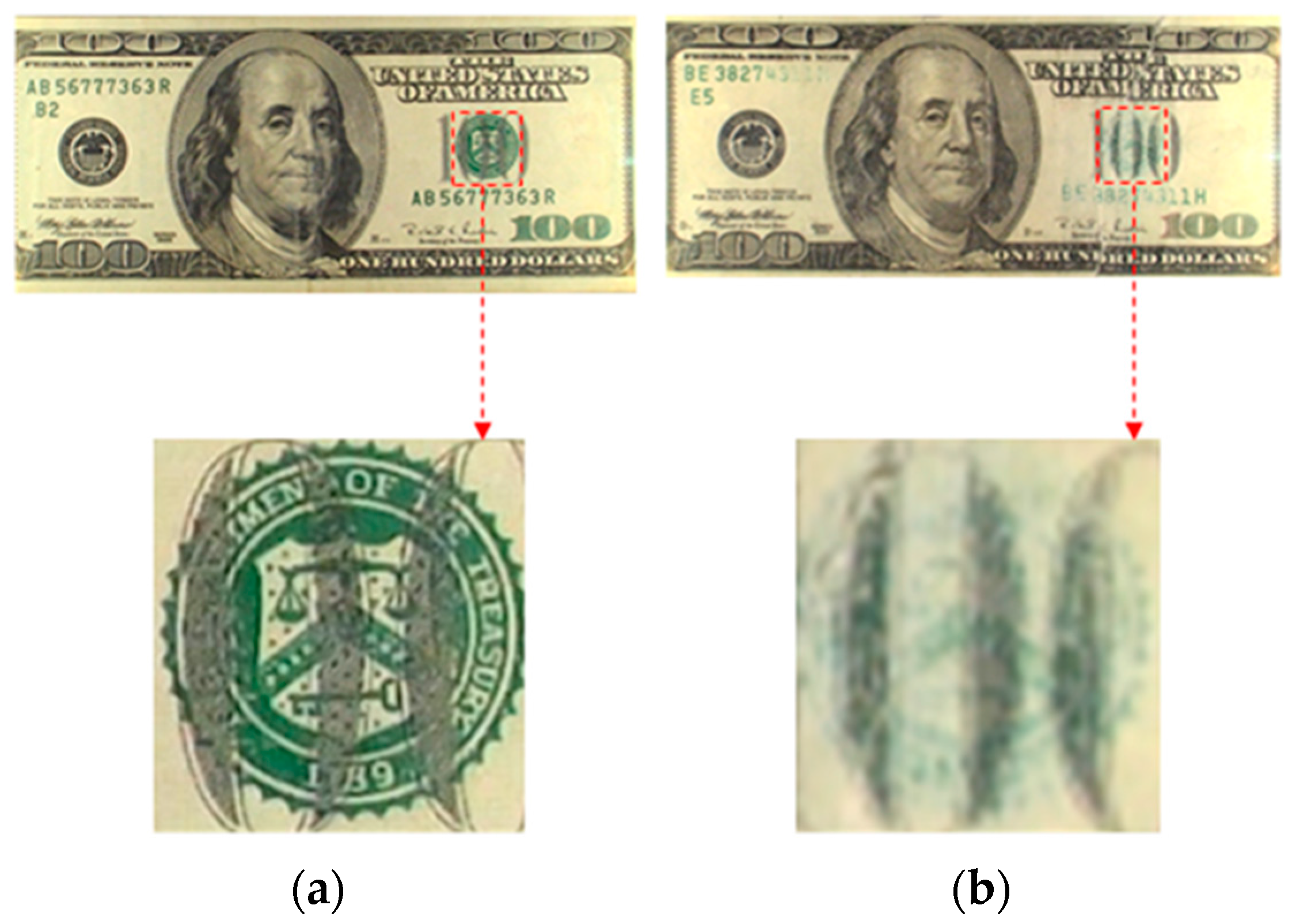
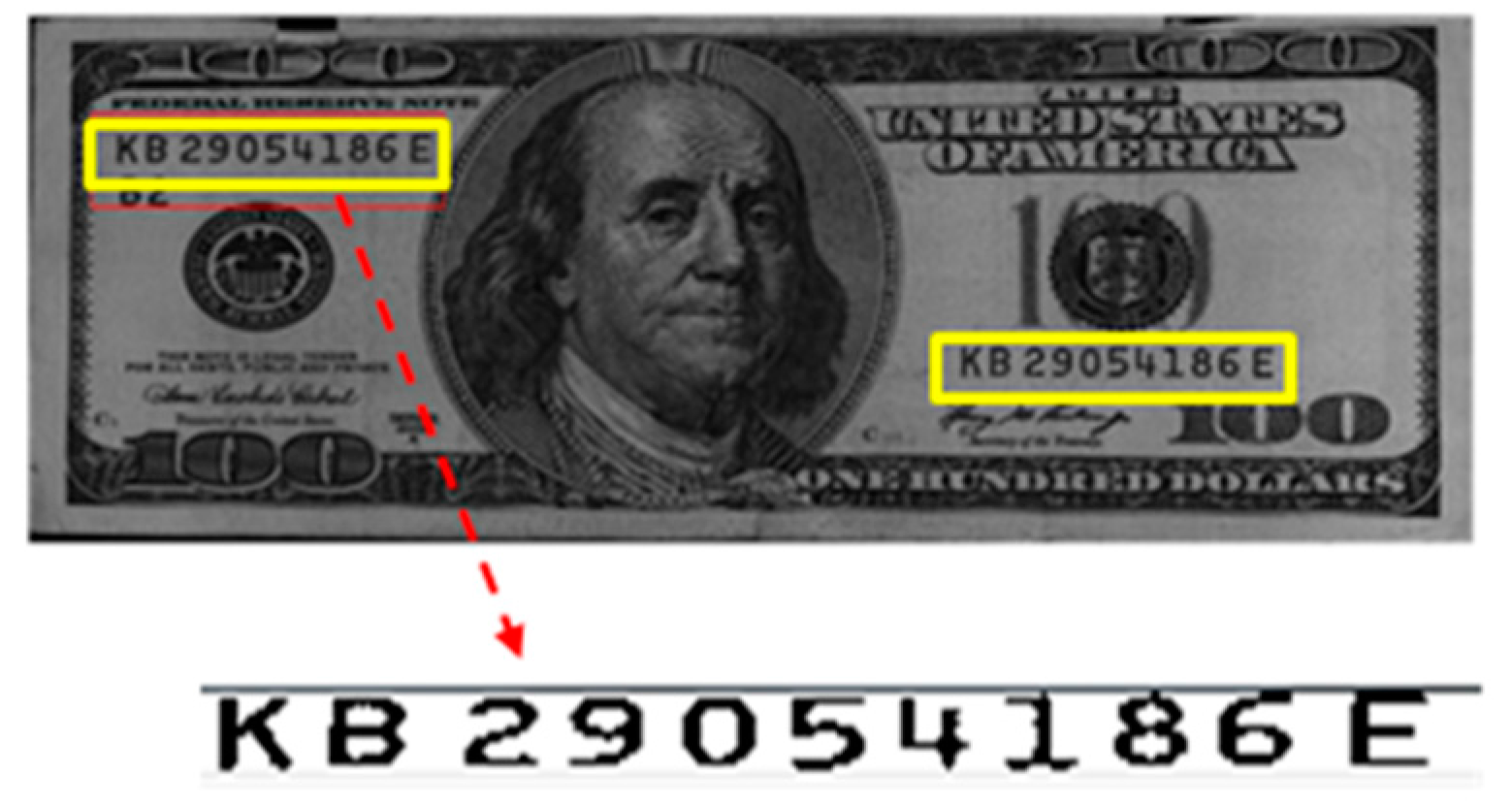

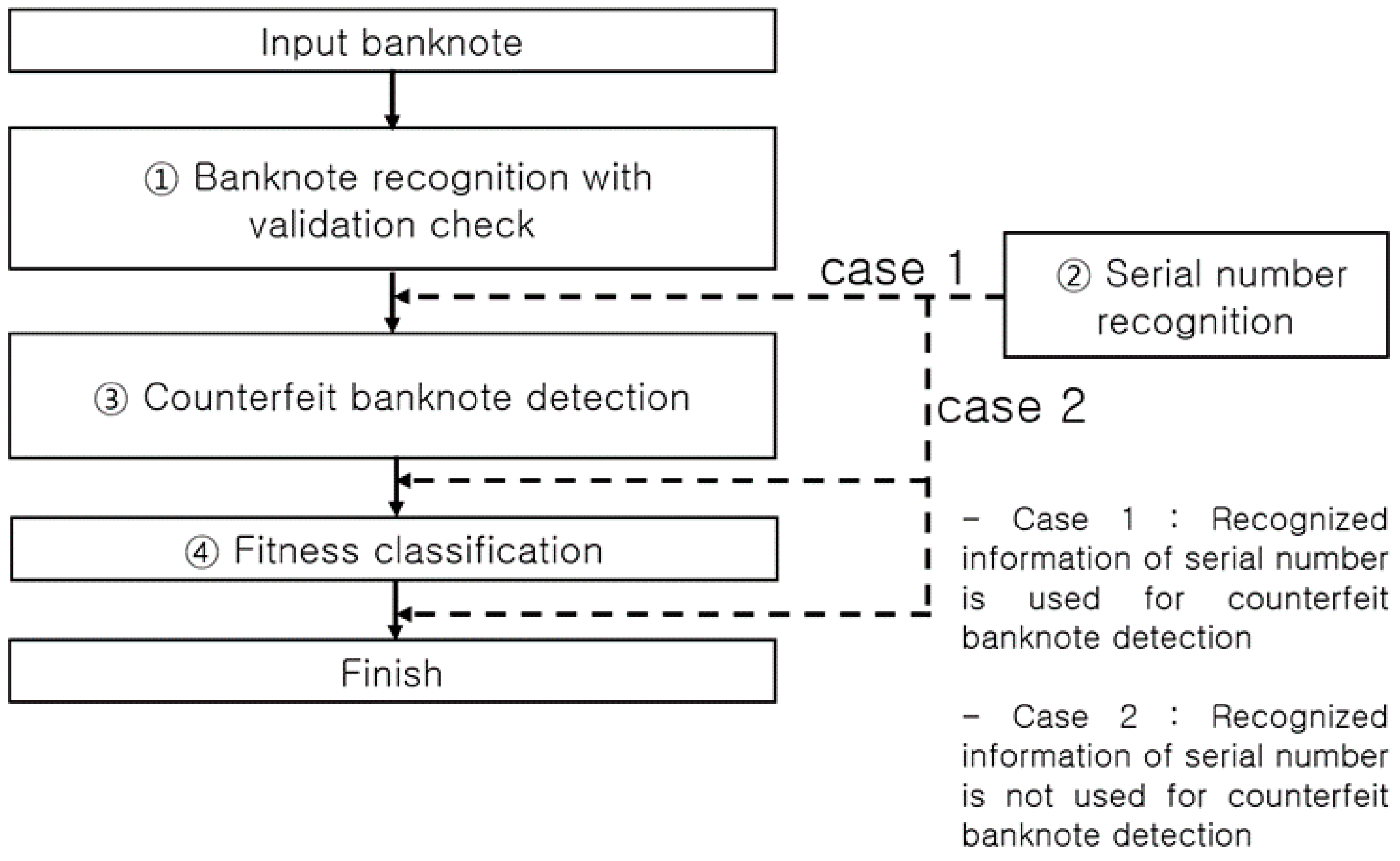

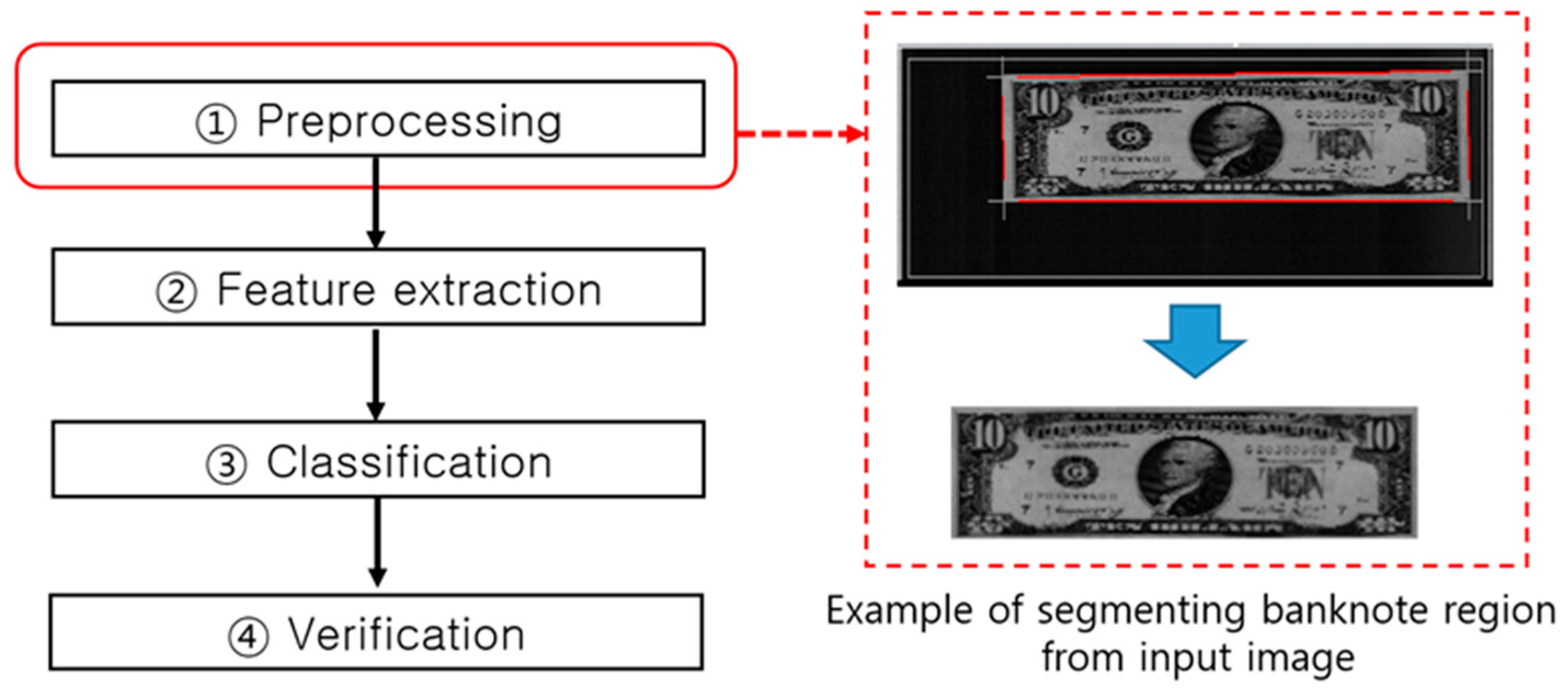
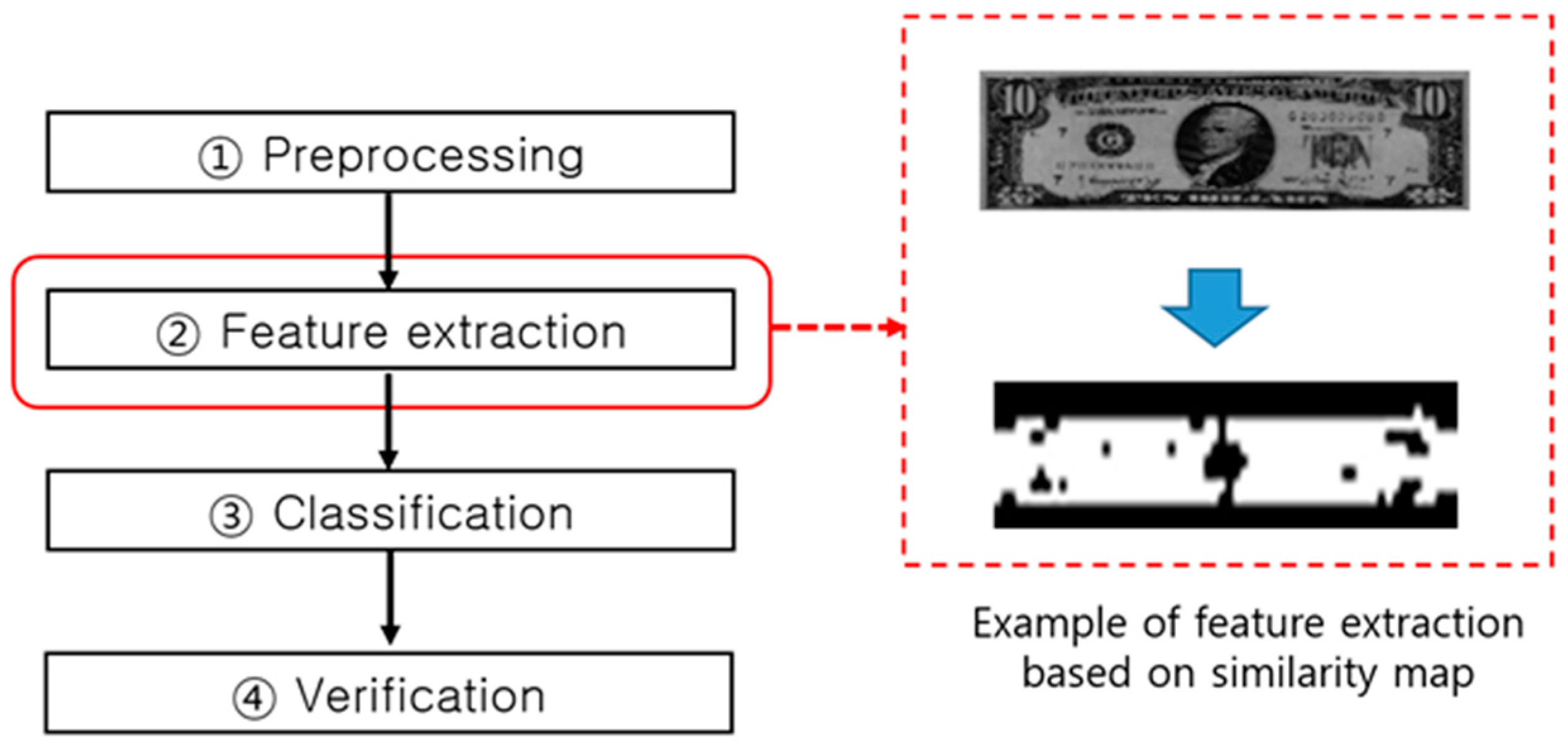
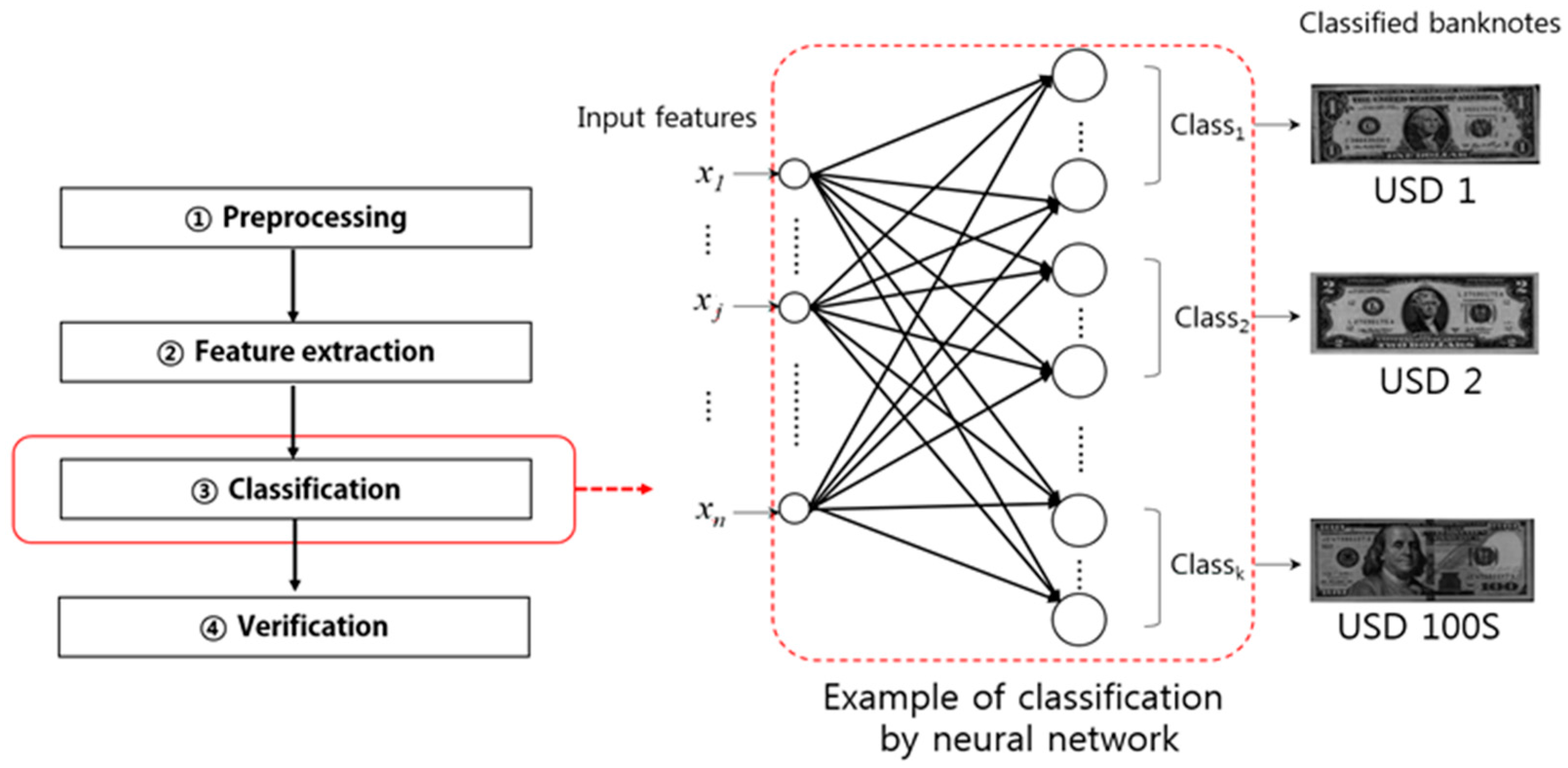
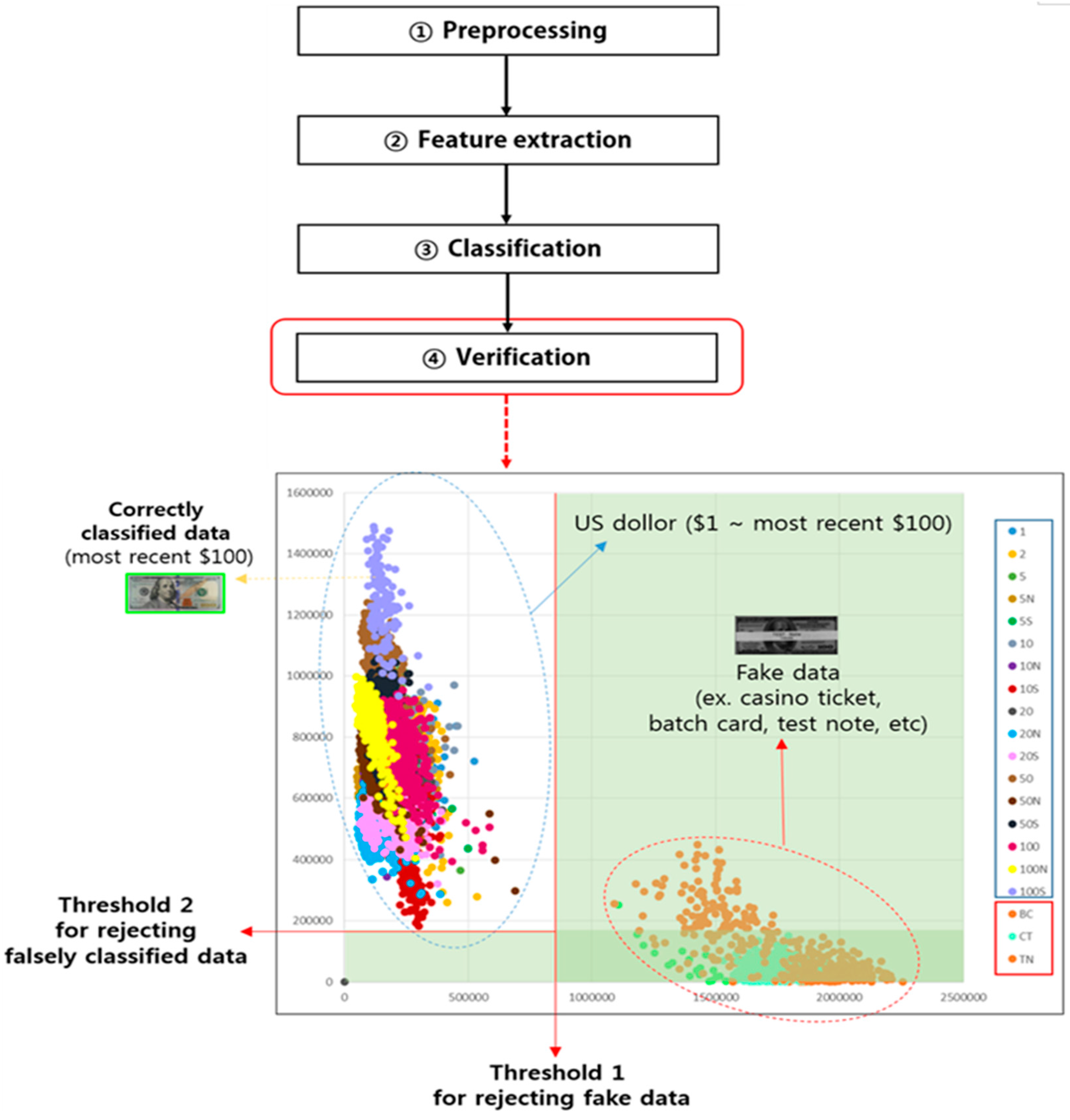
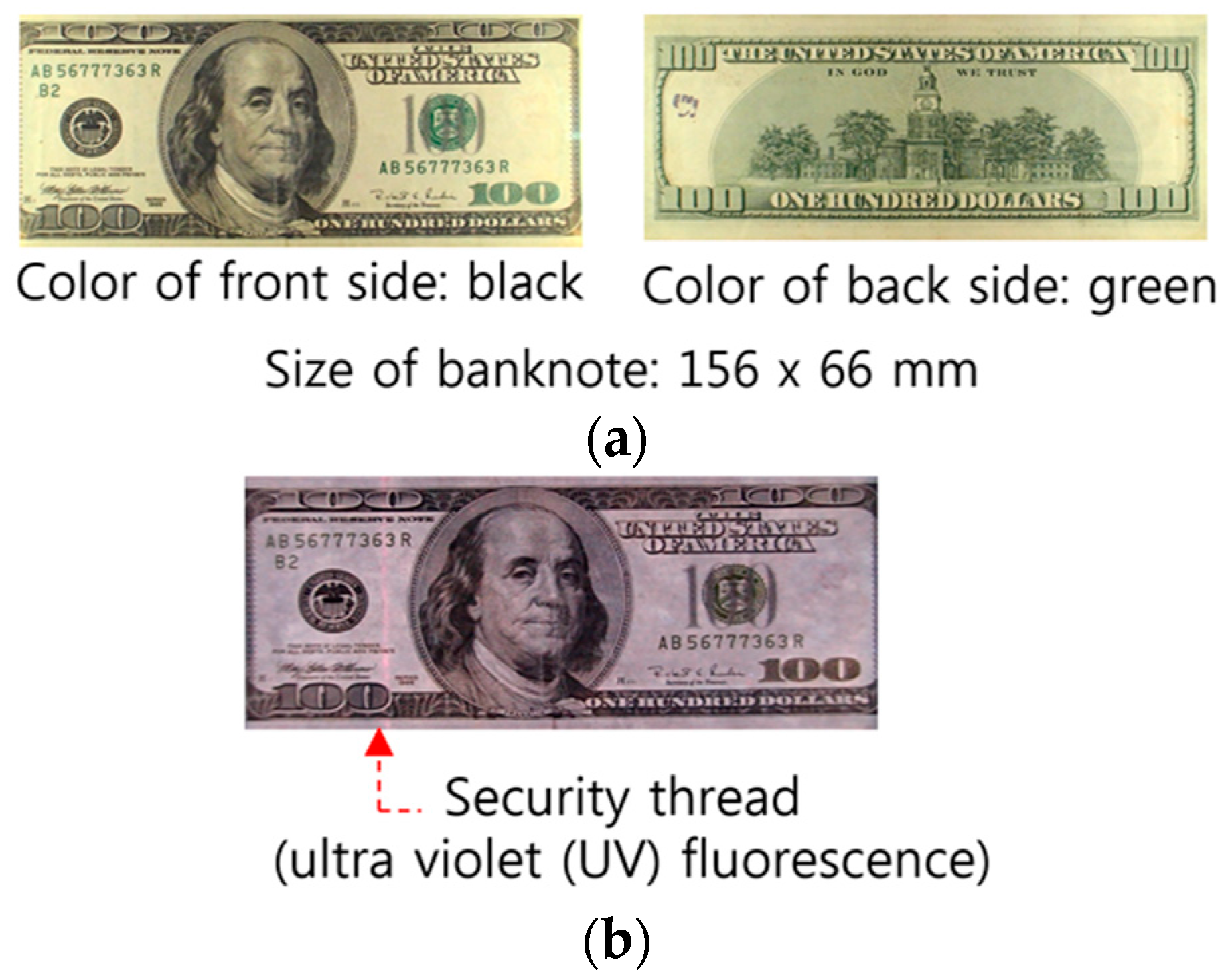

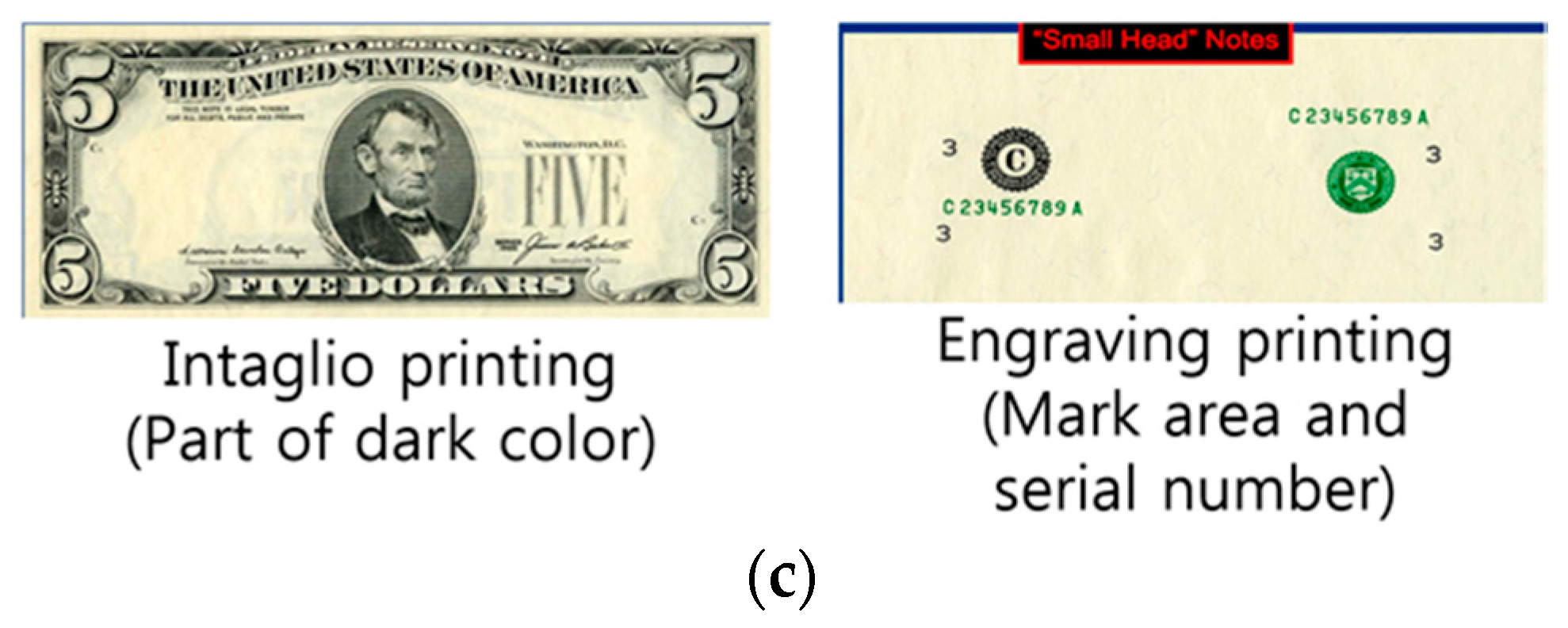

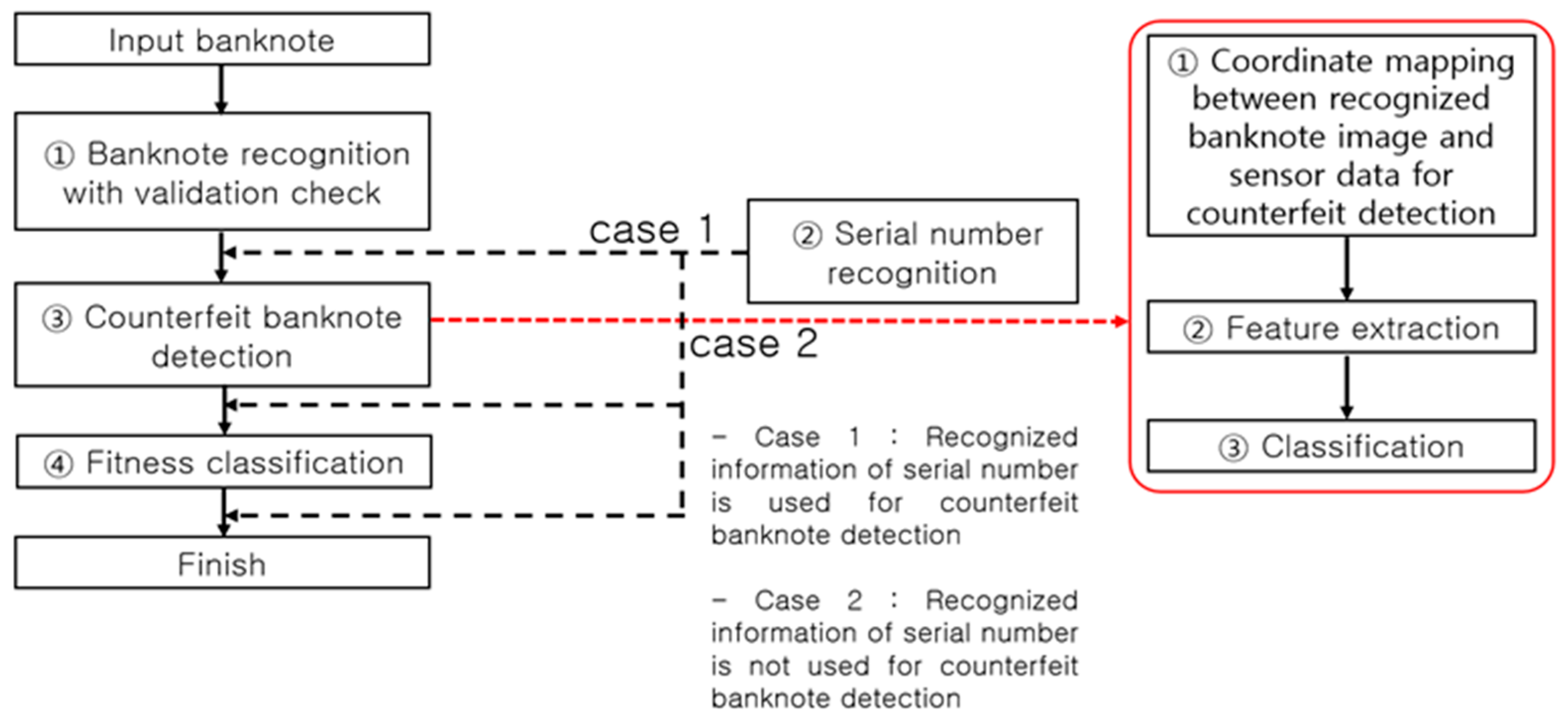
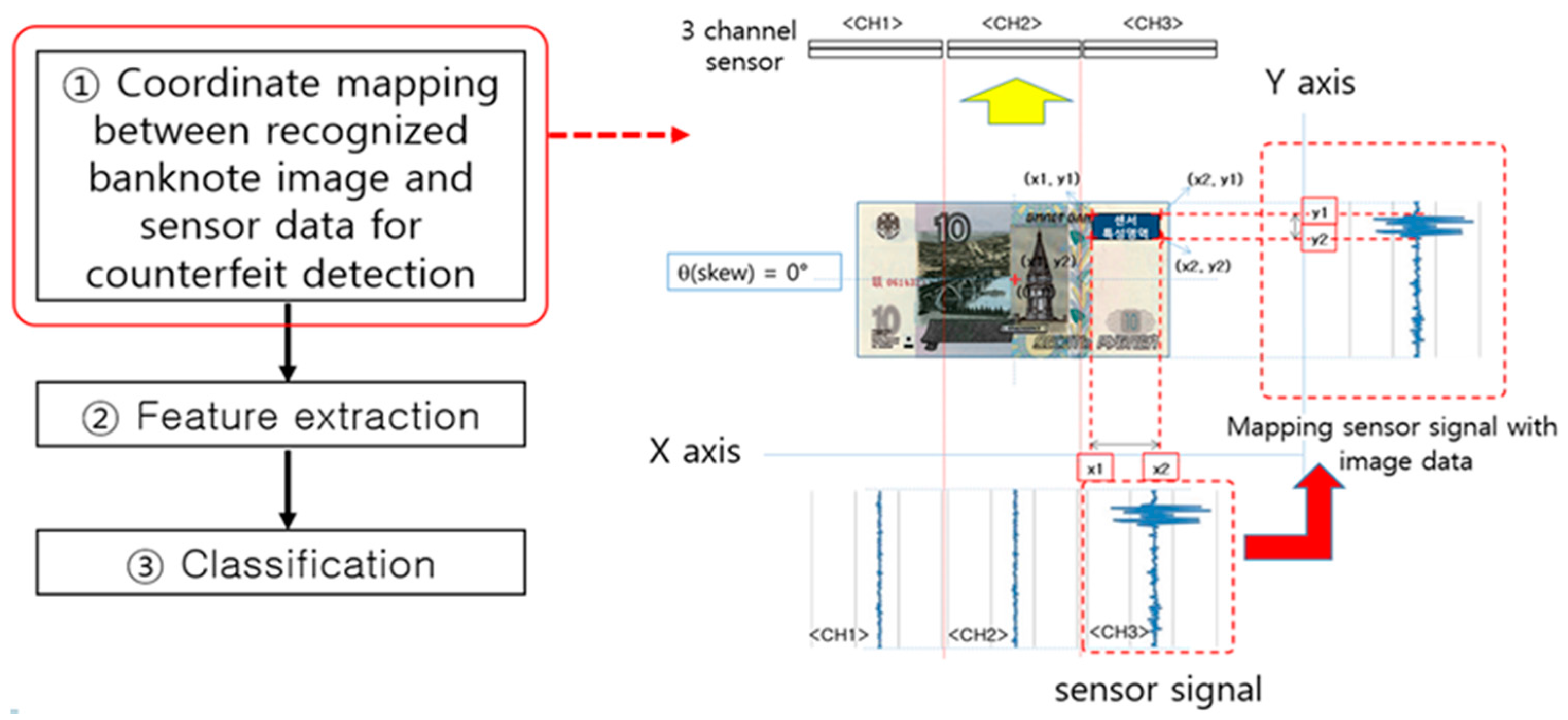
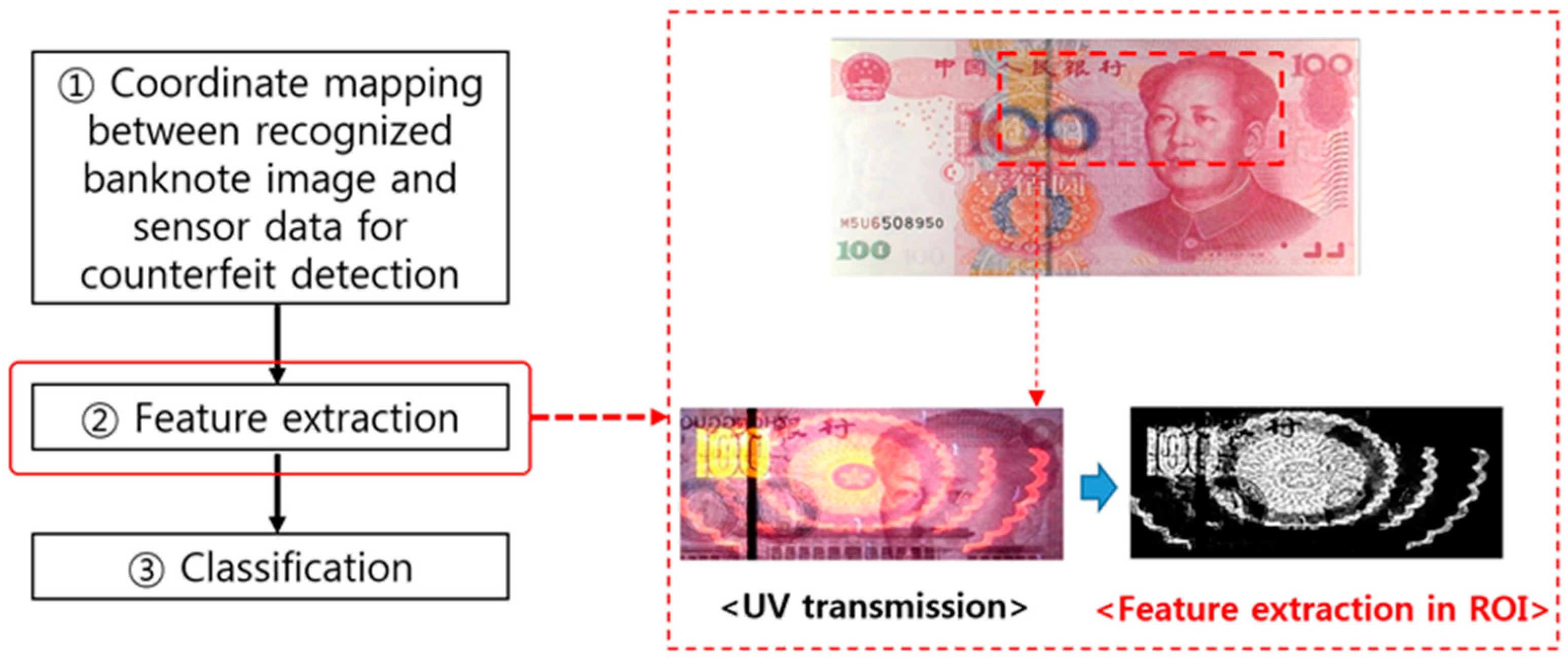
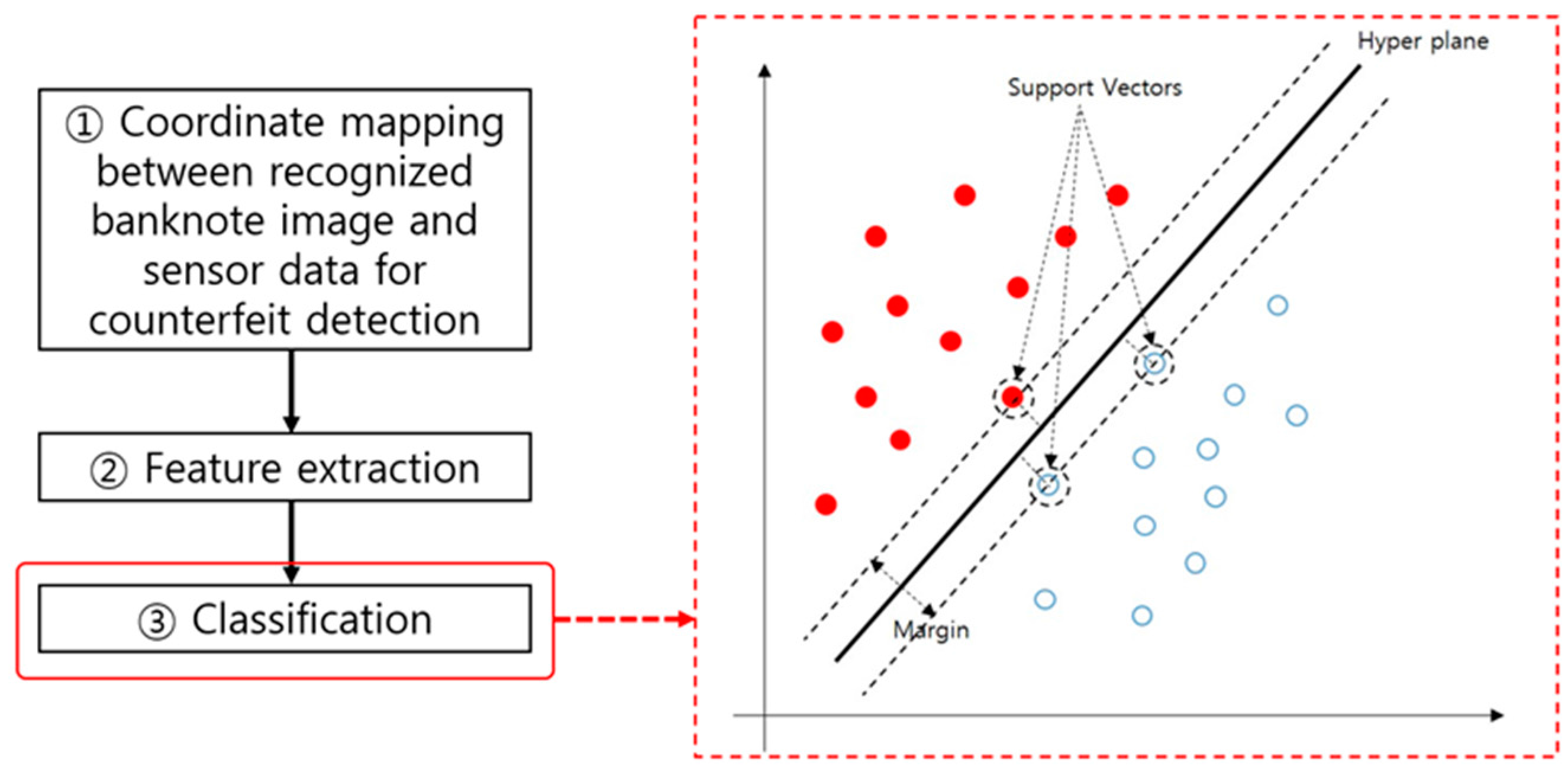
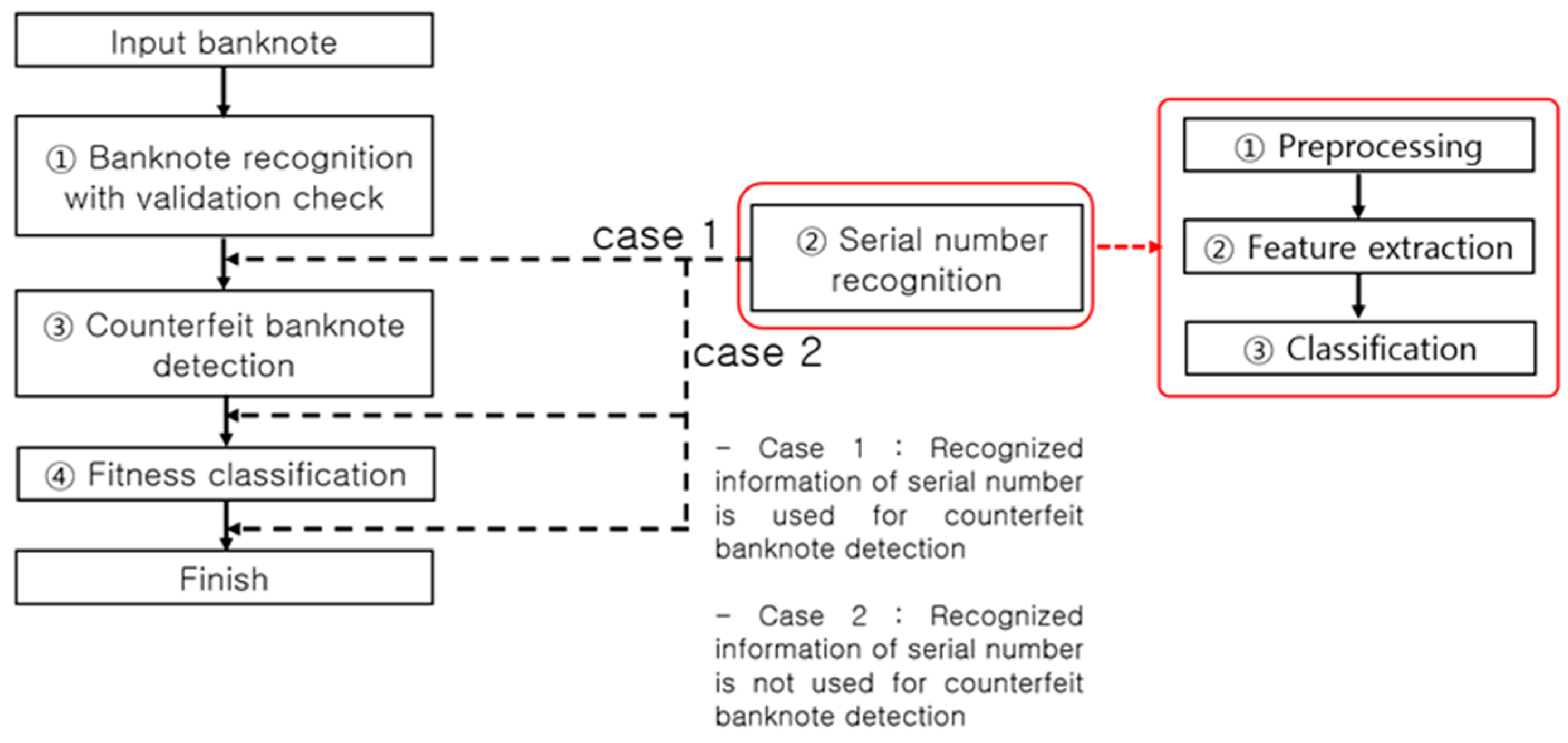
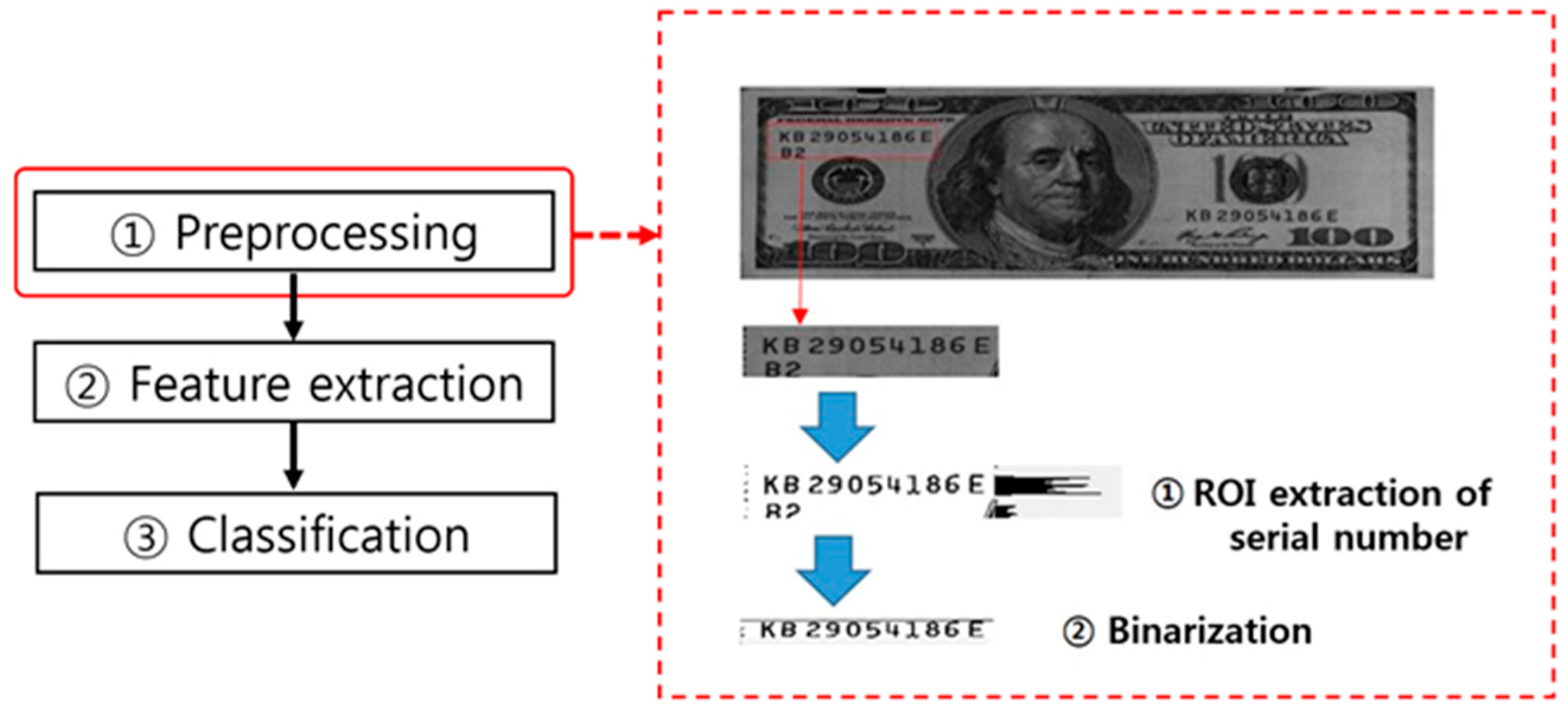
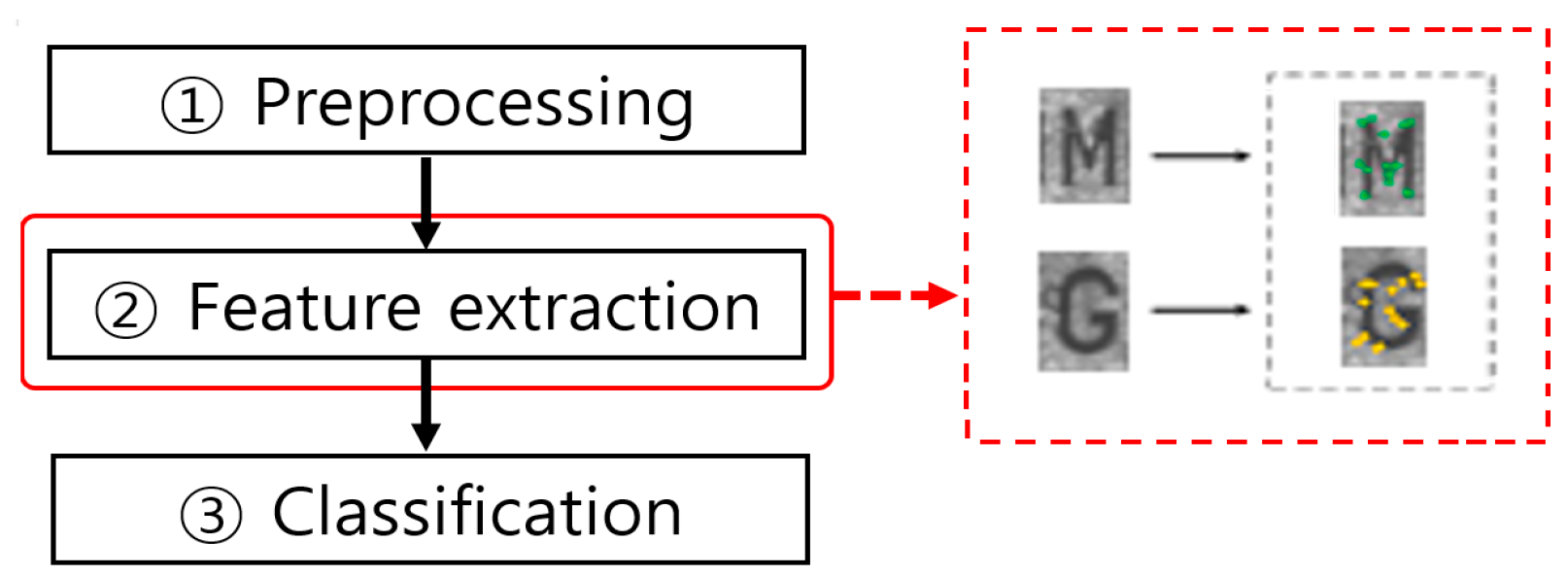




| Recognition Mode | National Currency | References | Databases | Availability of Database | ||
|---|---|---|---|---|---|---|
| Ref. | #Images | #Denomination Kind | ||||
| Single Currency Recognition | United States (USD) | [8,9,15,16,17,18,19,20,21,22,23,24,25] | [8] | 61,240 | 16 | N/A |
| [9] | 99,236 | 17 | N/A | |||
| [15,22] | 3570 | 6 | N/A | |||
| [16] | 15,000 | 6 | N/A | |||
| [19] | 65,700 | 12 | N/A | |||
| China (CNY) | [11,12,13,16,26,27,28,29,30,31] | [11] | 297,200 | 3 | N/A | |
| [13] | 16,000 | 5 | N/A | |||
| [26] | 3360 | 4 | N/A | |||
| [28] | 20,000 | 5 | N/A | |||
| [30] | 1600 | 4 | N/A | |||
| Euro (EUR) | [16,32,33,34,35] | [16] | 15,000 | 7 | N/A | |
| [32] | 140 | 7 | N/A | |||
| [35] | 82 | N/I | N/A | |||
| India (INR) | [36,37,38,39,40,41,42,43] | [36] | 350 | 7 | N/A | |
| [38] | 39 | 3 | N/A | |||
| [41] | 504 | 6 | N/A | |||
| South Korea (KRW) | [44] | 10,800 | 3 | N/A | ||
| Iran (IRR) | [45,46,47,48] | [45] | 4000 | 8 | N/A | |
| [47] | 128 | 8 | N/A | |||
| [48] | 240 | 6 | N/A | |||
| Mexico (MXN) | [49,50] | 1600 | 5 | N/A | ||
| Australia (AUD) | [51,52] | [51] | 1320 | 6 | N/A | |
| South African (ZAR) | [9] | 760 | 10 | N/A | ||
| New Zealand (NZD) | [53] | 367 | 5 | N/A | ||
| Sri Lanka (LKR) | [54] | 280 | 4 | N/A | ||
| Pakistan (PKR) | [55] | 120 | 6 | N/A | ||
| Angola (AOA) | [9] | 1366 | 9 | N/A | ||
| Italy (ITL) | [56,57,58] | [57] | 80 | 8 | N/A | |
| [58] | 30 | 8 | N/A | |||
| Saudi Arabia (SAR) | [37,59,60] | [37] | 4 | 2 | N/A | |
| [59] | 300 | 3 | N/A | |||
| [60] | 110 | 1 | N/A | |||
| Jordan (JOD) | [14] | 500 | 10 | A | ||
| Ethiopia (ETB) | [61] | 240 | 5 | N/A | ||
| Bangladesh (BDT) | [62,63] | [62] | 1700 | 8 | N/A | |
| [63] | N/I | 7 | N/A | |||
| Myanmar (MMK) | [64] | 89 | 5 | N/A | ||
| Malawi (MWK) | [9] | 2464 | 6 | N/A | ||
| Multi-Currency Simultaneous Recognition | USD, EUR, KRW, CNY, Russia (RUB) | [10] | 100,797 from 5 national currencies | 55 from 5 national currencies | N/A | |
| 23 countries (CNY, EUR, INR, USD, etc.) | [65] | 150 from 23 national currencies | 101 from 23 national currencies | N/A | ||
| Turkey (TRY), Cyprus (CYP) | [66] | 180 (TRY), 144 (CYP) | 5 (TRY), 4 (CYP) | N/A | ||
| USD, EUR | [67] | N/I | 4 (USD), 7 (EUR) | N/A | ||
| USD, Japan (JPY) | [68] | 132 (USD), 50 (JPY) | 6 (USD), 3 (JPY) | N/A | ||
| JPY, ITL, Spain (ESP), France (FRF) | [69] | 165 (JPY), 440 (ITL), 385 (ESP), 275 (FRF) | 3 (JPY), 8 (ITL), 7 (ESP), 5 (FRF) | N/A | ||
| USD, EUR, BDT, INR | [70] | 300 (USD), 300 (EUR), 500 (BDT), 300 (INR) | 3 (USD), 3 (EUR), 5 (BDT), 3 (INR) | N/A | ||
| Task | Method | References |
|---|---|---|
| Banknote region segmentation | Corner detection | [8,9] |
| Least square method and fuzzy system | [12] | |
| Component labeling based on the Y component of YIQ space | [68] | |
| Noise removal and gray level reduction | Weiner filtering | [10,49,55,65,71] |
| Median filtering | [42,64] | |
| Gray level reduction | [54,65,71,72] | |
| Brightness normalization and contrast enhancement | Histogram equalization | [42,45] |
| Image resolution reduction | Nearest neighbor interpolation | [10,67] |
| Image channel reduction | Conversion of color to gray | [23,39,46,55,63,72] |
| Method | References |
|---|---|
| Features of banknote size or length | [45,56,60,65,68,72] |
| Color information (RGB, HSV, or HSI) | [37,40,45,49,50,61,68] |
| Edge information (Canny, Prewitt, or Sobel operator) | [40,44,54,60] |
| Histogram information (correlation, central moments, kurtosis, mean, standard deviation, skewness, etc.) | [39,43,53,59,64,65] |
| Local binary patterns (LBP) | [41,49] |
| Gray-level co-occurrence matrix (GLCM) | [39,53,64] |
| Principle component analysis (PCA) | [8,9,15,20,21,22,23,26,46] |
| Linear discriminant analysis (LDA) | [43,46,70] |
| Genetic algorithm (GA) | [24,30,69,73] |
| Similarity map or difference map | [9,10,19] |
| Discrete wavelet transform (DWT) | [11,16,44,47,48] |
| Scale-invariant feature transform (SIFT) or speeded up robust features (SURF) | [14,17,18,25,35,36,61,67,74] |
| Compressed sensing | [27] |
| Features by optical character recognition (OCR) | [38] |
| Features from selected ROI | [8,9,13,17,20,23,30,32,36,38,39,43,48,59,68] |
| Methods | References | |
|---|---|---|
| Classification | Euclidean distance-based classifier | [36,37,41,42,48,51] |
| Mahalanobis distance-based classifier | [23] | |
| NN (LVQ network, ENN and PNN, etc.) | [15,16,20,21,22,24,26,29,30,31,32,33,34,38,45,46,47,49,53,54,56,57,58,62,63,66,69,72,73] | |
| SVM | [8,11,39,43,67,71] | |
| HMM | [13,65,71] | |
| K-means algorithm | [8,9] | |
| K-NN method | [55,64] | |
| Preclassification (based on banknote side, direction, size, or a Gaussian mixture model (GMM)) | [8,10,32,75] | |
| Verification | Verification (based on the validity of matching distance or banknote size) | [9,54] |
| References | Features and Advantages |
|---|---|
| [8] | Banknote counter DSP processing (processing time: 15.6 ms), preclassification of the banknote input side (SVM), number of experimental data points (61,240 notes), accuracy (USD: 99.886%) |
| [73] | Banknote counter DSP processing (banknote counting machine by Glory Corp.), GA-based selection of optimal mask and use of a NN, number of experimental data points (100,000 notes), accuracy (USD and JPY: ≥97%) |
| [9] | Banknote counter DSP processing, feature region selection using a similarity map, number of experimental data points (99,236 USD notes), accuracy (USD: 99.998%) |
| [10] | Simultaneous recognition of 5 national currencies (USD, EUR, KRW, CNY, RUB), ROI selection after using a similarity map, number of experimental data points (84,800 of 5 kinds of banknote), accuracy (100%) |
| [16] | Quaternion WT-based data extraction of the magnitude, horizontal, vertical, and diagonal data of banknote images and coefficient feature extraction using the generalized Gaussian density function, number of experimental data points (15,000 USD, CNY, EUR notes each), accuracy (≥99% on average) |
| [65] | Simultaneous recognition of 23 national currencies including USD, EUR, INR, and CNY, banknote texture feature modeling using size data and a HMM, number of experimental data points (150 per denomination), recognition rate (98%) |
| [67] | ATM DSP processing (processing time: 54 ms), simultaneous recognition of USD and EUR using the dense SIFT feature extraction method, accuracy (≥99.8%) |
| [19] | Real-time embedded system processing (processing time: 16 m), valid feature region selection using the difference map, generalized learning vector quantization (GLVQ) classification, number of experimental data points (65700 USD notes), accuracy (99%) |
| [69] | GA-based selection of optimal mask, NN-based DSP simultaneous recognition of four national currencies (JPY, ITL, ESP, FRF) using a banknote counter, number of experimental data points (20,000 notes), accuracy (97%) |
| [74] | Multi-currency simultaneous recognition (INR, CNY, EUR, etc.) using a mobile camera and server communication system with a feature enabling overlapping multi-currency simultaneous recognition, recognition rate (95%) |
| Feature | Method | References |
|---|---|---|
| Brightness information | Y histogram of YIQ color space or luminance histogram | [83,84] |
| Fluorescence characteristics | UV pattern | [85,86,87] |
| X-Ray fluorescence | [88,89,90,91] | |
| Intrinsic fluorescence lifetime | [92] | |
| Fidelity of serial number and printing | Binarization, edge detection, and radial based function (RBF) NNs | [93] |
| Printing accuracy by tie point detection | [94] | |
| Security thread | Electromagnetic detection based on the pulsed eddy current technique | [95] |
| Infrared (IR) features | The middle IR spectrum of several areas in the banknotes | [96] |
| Near IR features | [75,82,97,98,99,100] | |
| Commercial system using multiple sensors including IR ray sensor | [101] |
| National Currency | References | Databases | Availability of Database | ||
|---|---|---|---|---|---|
| Ref. | #Images | #Denomination Kind | |||
| India (INR) | [84,87,99,102,103,104,105,106,107,108,109,110,111,112,113,114,115] | [87] | 1000 | 2 | N/A |
| [113] | 288 | 3 | N/A | ||
| Euro (EUR) | [88,94,96,98] | [96] | 18 | 2 | N/A |
| [98] | 2750 | 7 | N/A | ||
| United States (USD) | [88,91,92] | [91] | 120 | 2 | N/A |
| [92] | 10 | 5 | N/A | ||
| Kuwait (KWD) | [116] | 4 | 2 | N/A | |
| Nepal (NPR) | [117] | 240 | 1 | N/A | |
| Switzerland (CHF) | [118] | 82 | 2 | N/A | |
| Taiwan (TWD) | [83,119] | [83] | 99 | N/I | N/A |
| [119] | 200 | N/I | N/A | ||
| South Korea (KRW) | [85,86] | [85] | 360 | 3 | N/A |
| [86] | N/I | 9 | N/A | ||
| United Kingdom (GBP) | [95] | 3 | 2 | N/A | |
| China (CNY) | [86] | N/I | 1 | N/A | |
| Malaysia (MYR) | [86] | N/I | 1 | N/A | |
| Method | References |
|---|---|
| Features from intaglio printing, ink properties, artwork, fluorescence, or year of printing | [87,106] |
| Bit-plane slicing and Canny edge detection | [116] |
| Watermark segmentation | [105,106,108,110,113,114] |
| Luminance histograms and texture features from GLCM | [84] |
| DWT | [102] |
| Security thread information | [87,103,104,105,110,113,114] |
| Optically variable ink information | [106,110,113] |
| SIFT algorithm | [112] |
| Mean, standard deviation, skewness, entropy, and correlation in an ROI | [117] |
| Identification mark or number panels | [103,104,105,106] |
| Micro lettering or latent image | [104,106] |
| Method | References |
|---|---|
| Template matching or keypoint matching | [106,117] |
| Artificial NN | [121] |
| SVM | [84,87,119] |
| Multiple kernel SVM | [111] |
| National Currency | References | Databases | Availability of Database | ||
|---|---|---|---|---|---|
| Ref. | #Images | #Denomination Kind | |||
| China (CNY) | [93,122,123,124,125,126,127,128] | [122] | 40,000 | 2 | N/A |
| [125] | 5000 | N/I | N/A | ||
| [126,127] | 24,262 | 2 | A | ||
| India (INR) | [129,130,131,132] | [129,130] | 25 | 5 | N/A |
| Methods | References |
|---|---|
| Mean filtering for noise reduction | [122,123] |
| Adjustment of brightness, contrast, and gamma | [129] |
| Size normalization by bilinear interpolation | [124] |
| Binarization based on the area-ratio and block contrast | [125] |
| Gray-scale normalization | [126] |
| Method | References |
|---|---|
| Features from nine local regions and four key-point features | [122] |
| Gradient direction feature | [126] |
| Method | References |
|---|---|
| Euclidean distance-based matching | [122] |
| SVM | [123] |
| NN | [124,128] |
| Cascaded combination of multiple classifiers | [126] |
| National Currency | References | Databases | Availability of Database | ||
|---|---|---|---|---|---|
| Ref. | #Images | #Denomination Kind | |||
| Euro (EUR) | [100,133,134,135,136] | [100] | 800 | 4 | N/A |
| [133,136] | 9029 | 4 | N/A | ||
| India (INR) | [137,138] | [137] | 19,300 | 5 | N/A |
| [138] | 2300 | 6 | A | ||
| China (CNY) | [139,140] | [140] | 4400 | 1 | N/A |
| United States (USD) | [138] | 3856 | 7 | A | |
| South Korea (KRW) | [138] | 3956 | 4 | A | |
| Method | References |
|---|---|
| Gray pixel value | [133] |
| Color pixel value | [133,135,136] |
| Pixel values of visible light and NIR images | [100,134,138] |
| Gray level histogram | [139] |
| Mean and standard deviation from ROI by DWT | [137] |
| Acoustic features of banknotes | [141,142] |
© 2017 by the authors. Licensee MDPI, Basel, Switzerland. This article is an open access article distributed under the terms and conditions of the Creative Commons Attribution (CC BY) license ( http://creativecommons.org/licenses/by/4.0/).
Share and Cite
Lee, J.W.; Hong, H.G.; Kim, K.W.; Park, K.R. A Survey on Banknote Recognition Methods by Various Sensors. Sensors 2017, 17, 313. https://doi.org/10.3390/s17020313
Lee JW, Hong HG, Kim KW, Park KR. A Survey on Banknote Recognition Methods by Various Sensors. Sensors. 2017; 17(2):313. https://doi.org/10.3390/s17020313
Chicago/Turabian StyleLee, Ji Woo, Hyung Gil Hong, Ki Wan Kim, and Kang Ryoung Park. 2017. "A Survey on Banknote Recognition Methods by Various Sensors" Sensors 17, no. 2: 313. https://doi.org/10.3390/s17020313




